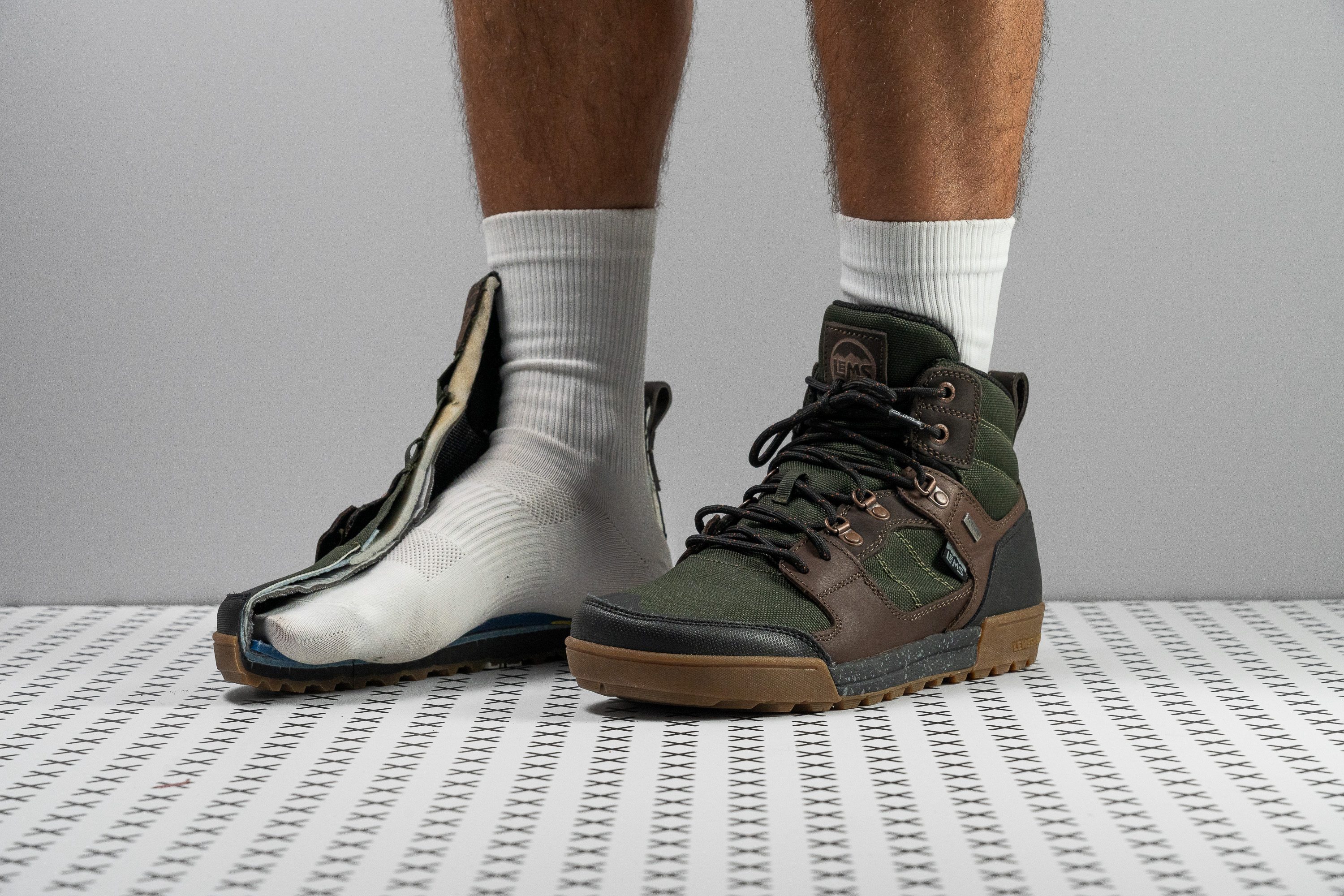Nuestra conclusión
Pros
- El diseño minimalista hace que la pisada sea más natural
- Ajuste amplio y con forma de pie
- Las botas impermeables perfectas para cualquier estación del año
- Agarre de primera en varios terrenos
- Más resistentes de lo que parece
- Más ligeras que la media
- Plataforma muy estable
- Plantilla ergonómica y cómoda
- Diseño flexible
Contras
- De drop cero nada (¡Su drop es de 8 mm!)
- La altura de la suela no coincide con lo que dice la marca
- Ponérselas podría ser más fácil
Veredicto de los usuarios
- Top 5% entre botas de senderismo
- Top 10% entre botas de senderismo de cuero
Comparativa
Las botas de senderismo más parecidas
+ + Añadir unas zapatillas | |||||
|---|---|---|---|---|---|
| Puntuación global | 92 Excelentes | 90 Notables | 87 Notables | 85 Notables | |
| Precio | 210 € | 210 € | 140 € | 160 € | |
| Terreno de trail | SencilloModerado | SencilloModerado | Sencillo | Moderado | |
| Absorción de impactos | - | Baja | Moderada | - | |
| Retorno de energía | - | Bajo | Moderado | - | |
| Peso laboratorio Peso marca | 15.3 oz / 434g | 17 oz / 482g 17 oz / 482g | 15.5 oz / 439g 15.7 oz / 444g | 18.2 oz / 515g 17.4 oz / 493g | |
| Lightweight | ✓ | ✓ | ✓ | ✗ | |
| Transpirabilidad | Baja | Baja | Baja | Baja | |
| Uso | Senderismo de un díaSenderismo ligeroSenderismo urbano | Senderismo de un díaSenderismo ligeroSenderismo urbano | Senderismo ligeroSenderismo urbanoPara principiantes | TrekkingSenderismo de un díaSenderismo ligero | |
| Orthotic friendly | ✓ | ✓ | ✓ | ✓ | |
| Drop laboratorio | 8.1 mm | 13.5 mm | 12.3 mm | 12.9 mm | |
| Talla | Media talla más pequeñas | Tallan bien | Tallan bien | Tallan bien | |
| Rigidez de la mediasuela | Equilibrada | Firme | Blanda | Firme | |
| Diferencia de la rigidez de la mediasuela en frío | Pequeña | Pequeña | Estándar | Pequeña | |
| Rigidez del contrafuerte del talón | Flexible | Firme | Flexible | Flexible | |
| Flexibilidad | Flexible | Moderada | Flexible | Moderada | |
| Dureza de la suela | Estándar | Muy dura | Estándar | Blanda | |
| Impermeabilización | Impermeables | Impermeables | Impermeables | Impermeables | |
| Material | Piel o cueroTextil | Ante | Textil | Piel o cuero | |
| Estación | Invierno | Invierno | Invierno | Invierno | |
| Durabilidad de la parte delantera | Decente | Decente | Mala | Buena | |
| Durabilidad del acolchado del talón | Media | Media | Media | Media | |
| Durabilidad de la suela exterior | Mala | Decente | Decente | Mala | |
| Anchura / ajuste | Ancha | Media | Estrecha | Ancha | |
| Anchura de la parte delantera | Ancha | Media | Estrecha | Ancha | |
| Profundidad del dibujo de la suela | 3.5 mm | 3.7 mm | 3.0 mm | 4.2 mm | |
| Altura de la suela en la zona del talón laboratorio | 28.9 mm | 32.7 mm | 31.5 mm | 31.1 mm | |
| Antepié | 20.8 mm | 19.2 mm | 19.2 mm | 18.2 mm | |
| Anchuras disponibles | Estándar | Estándar | Estándar | EstándarAncho | |
| Tecnología | - | Ortholite | - | Ortholite | |
| Cut | Corte medio | Corte medio | Corte medio | Corte medio | |
| Removable insole | ✓ | ✓ | ✓ | ✓ | |
| Clasificación | #2 Top 5% | #8 Top 20% | #17 Top 42% | #25 39% inferior | |
| Popularidad | #31 24% inferior | #32 21% inferior | #28 31% inferior | #23 43% inferior |
Quién debería comprárselas
Las Lems Outlander deberían estar en tu lista de deseos si estás buscando:
- Unas botas de senderismo minimalistas con un drop y una suela bajos, así como una estructura flexible.
- Un par para irte de aventuras con mucho espacio para los dedos.
- Unas botas impermeables de las que disfrutar durante todo el año.
- Unas botas con un estilazo y un diseño que te recuerda al planeta Tierra (nada demasiado deportivo).
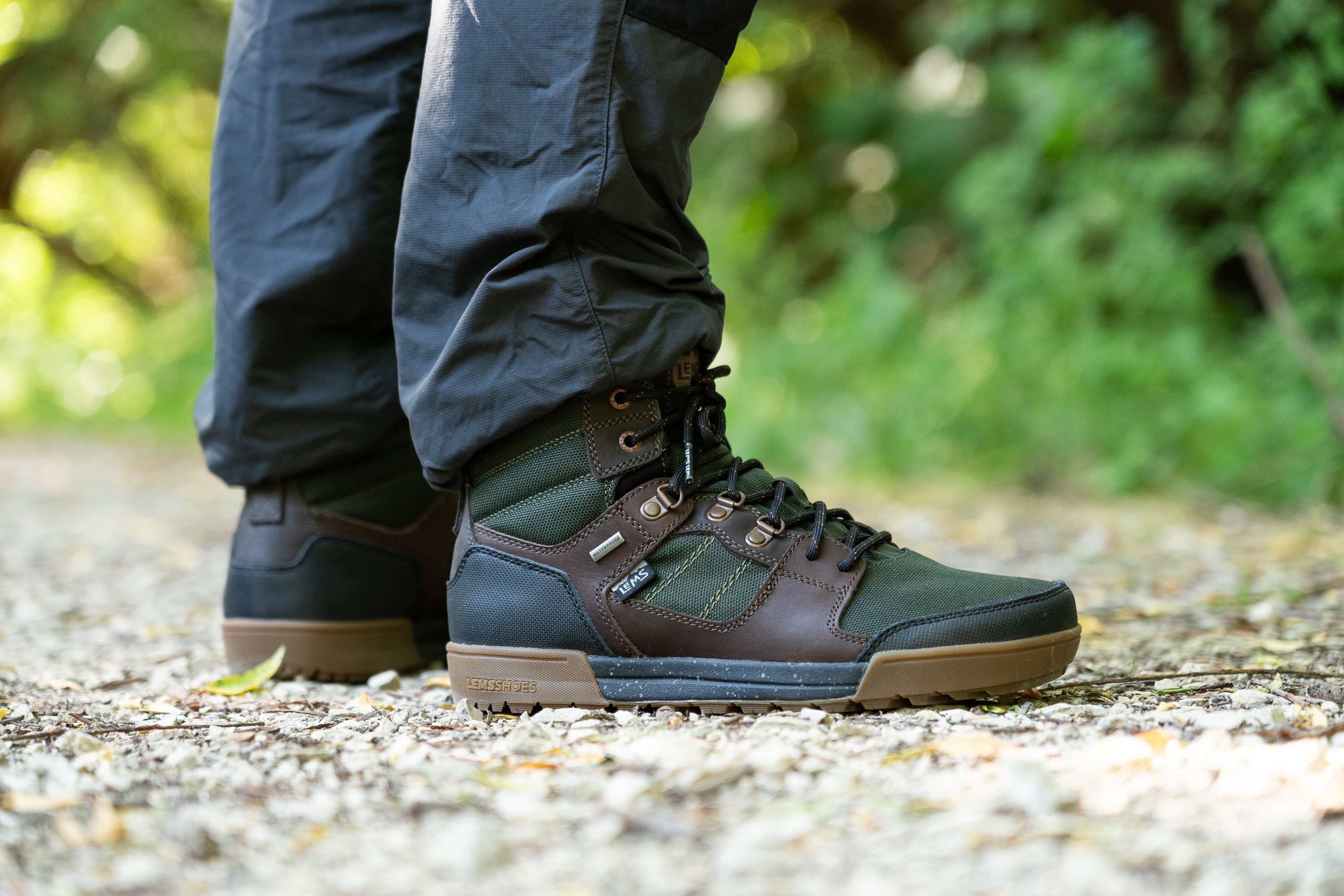
Quién NO debería comprárselas
Las personas que estén buscando unas botas minimalistas con un drop de 0 mm deberían de pasar de estas, ya que nuestro calibre marcó 8 mm cuando lo medimos.
Si es tu caso, te recomendamos que les eches un ojo a las Altra Lone Peak Hiker 2, ya que nuestras mediciones confirmaron que su drop es de 2,6 mm.
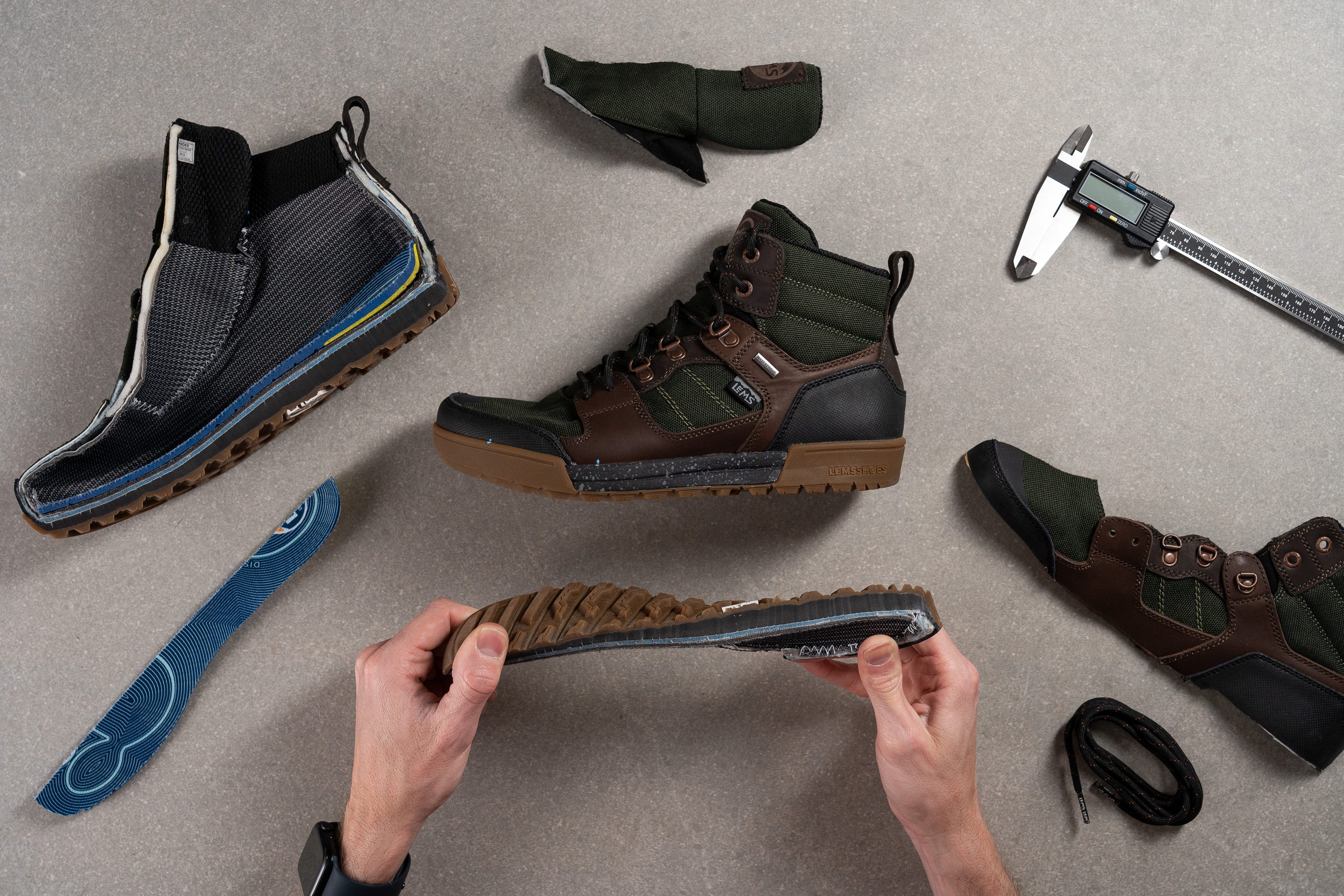
Amortiguación
Altura de la suela en la zona del talón
Lems se dedica a fabricar calzado que resulte lo más natural posible al caminar, así que sus botas de senderismo tienen suelas más finas y bajitas. En teoría, las Outlander tienen una suela de solo 16 mm.
Pero, después de medirlas en el laboratorio, nos dimos cuenta de que para nada.
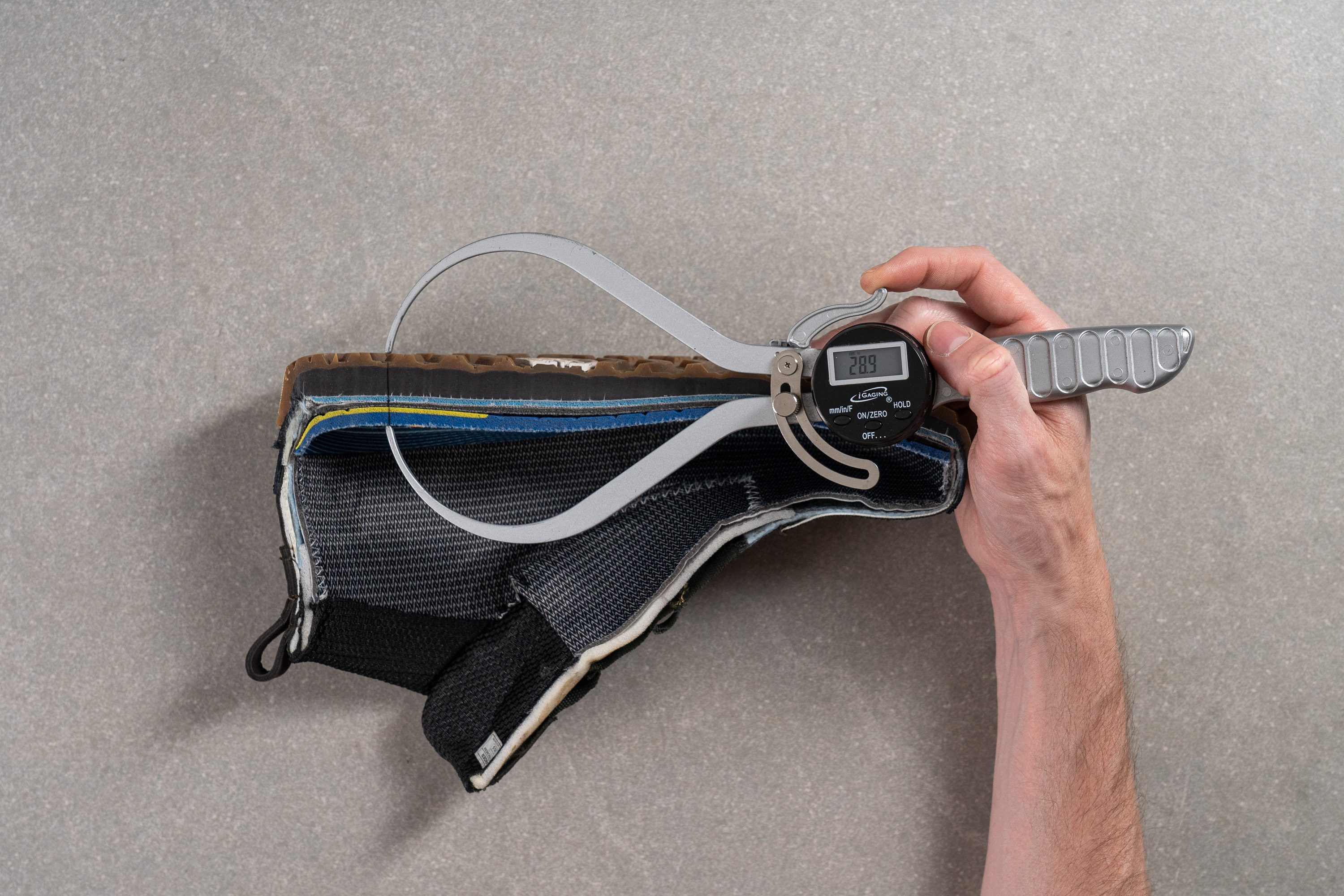
Cuando medimos la altura de la suela en la zona del talón, ¡nuestro calibre marcó 28,9 mm! Incluso si le quitamos la plantilla (7,2 mm) y los tacos (3,6 mm), todavía nos quedan 18,1 mm. Por eso no estamos muy seguros de lo que Lems entiende por altura de suela, teniendo en cuenta que se supone que es la cantidad de material entre el pie y el suelo.
Lo que sí es cierto es que las Outlander tienen una de las suelas más finas que hemos visto, y solo las superan las Altra Lone Peak Hiker 2 (26,4 mm).
Aunque el suelo sí se siente bajo los pies, también notamos que teníamos protección suficiente bajo la planta de los pies para estar cómodos con estas botas.
| Outlander | 28.9 mm |
| Media | 36.3 mm |
Altura de la suela en el antepié
Nuestro calibre marcó 20,8 mm cuando medimos la altura de la suela en el antepié. Una vez más, es mayor que los 16 mm que declara la marca, y está a la par con la media de las botas de senderismo.

Sentimos que nuestros metatarsos estaban protegidos de los palos y piedras que íbamos pisando, a la vez que disfrutábamos de una estructura flexible. Al fin y al cabo, las botas con suelas más altas son mucho más difíciles de doblar en el antepié, aunque ofrecen más protección.
| Outlander | 20.8 mm |
| Media | 23.0 mm |
Drop
Mucho ojo: ¡El drop de estas botas no es 0!
El mayor cambio que les vimos a las Lems Outlander de lo que decía la marca a los resultados de nuestro laboratorio fue su drop. Según la página oficial, el drop debería ser 0.
Pero nuestro calibre reveló que el resultado estaba MUY lejos de eso, ¡ya que nos dio 8 mm!

Aunque para algunas personas esto sí que puede ser un problema, otras probablemente ni siquiera noten la diferencia entre un drop de 0 mm y uno de 8 mm. ¡Pero nosotros estamos aquí para señalar estas incoherencias!
También queremos destacar que, aunque no nos esperábamos que estas botas tuviesen un drop de 8 mm, sigue siendo más bajo que la media del sector, de 14 mm.
| Outlander | 8.1 mm |
| Media | 13.3 mm |
Suavidad de la mediasuela
La forma en la que Lems ve el calzado no implica que la amortiguación tenga que ser tan blandita como una nube, solo que haya la menor distorsión posible en el contacto del pie con el suelo. ¡Y las Outlander se centraron en que la experiencia fuese bastante firme!
Nuestro durómetro marcó 30,0 HA cuando medimos la dureza de la espuma. No es la mediasuela más firme que hemos visto en unas botas de senderismo (¡hola, Danner!), pero sin duda entra dentro del rango de las más firmes.
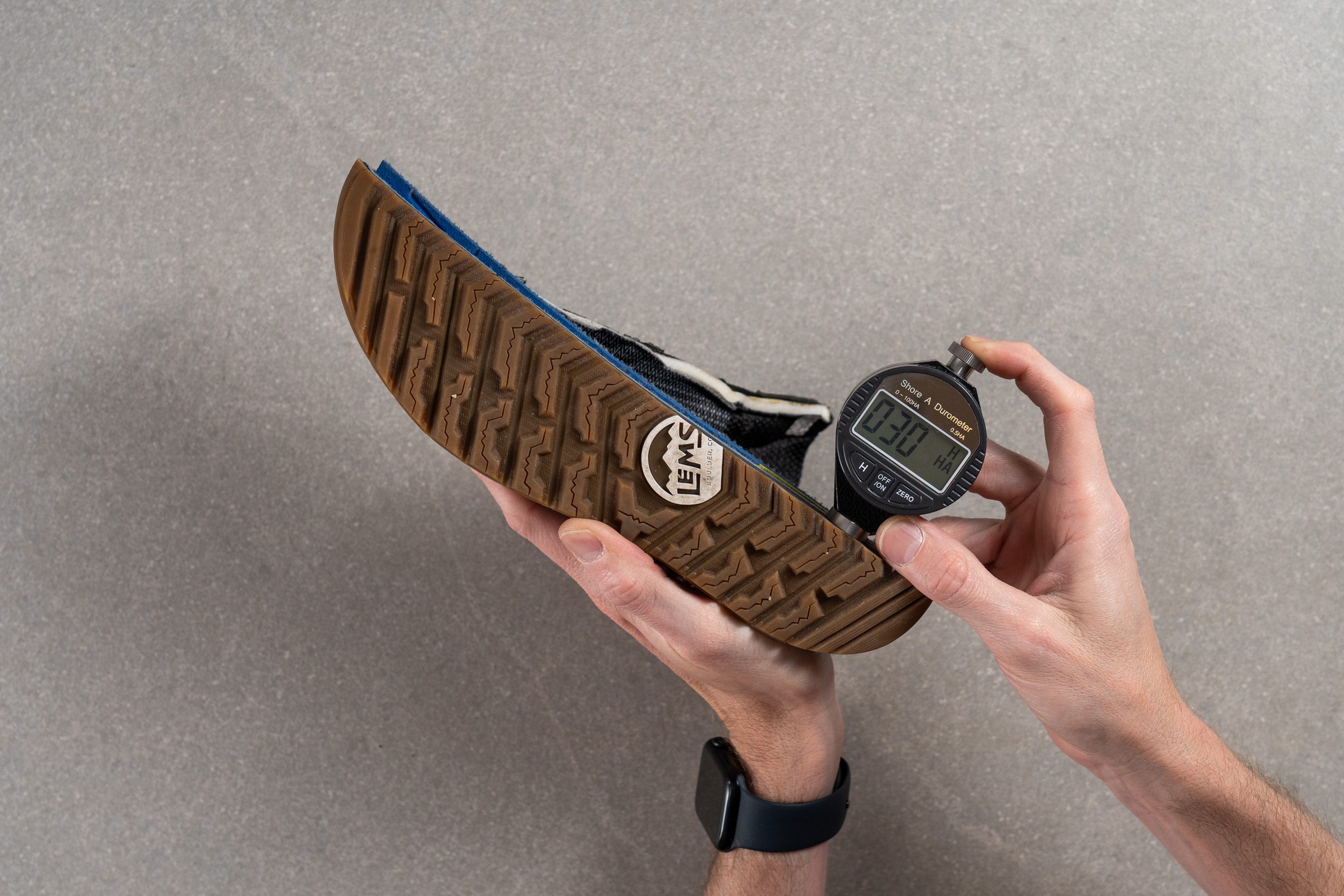
Una menor amortiguación se traduce en un mejor equilibrio y un contacto más "directo" con la superficie.
| Outlander | 30.0 HA |
| Media | 28.4 HA |
Tallaje y ajuste
Talla
Las Lems Outlander son media talla más pequeñas (14 votos).
Plantéate subir media talla
Longitud interna
Al comprarnos las Lems Outlander en nuestra talla de hombre de siempre, que es la 9 estadounidense, nos sorprendió que de hombre, la 9, nos sorprendió que se quedasen un poco cortas para nuestros pies (263 mm).
Según la tabla de tallas de Lems, la longitud de la plantilla de sus botas de la talla 9 estadounidense debería ser de 268 mm, pero cuando la medimos en el laboratorio nos dio 261,7 mm.
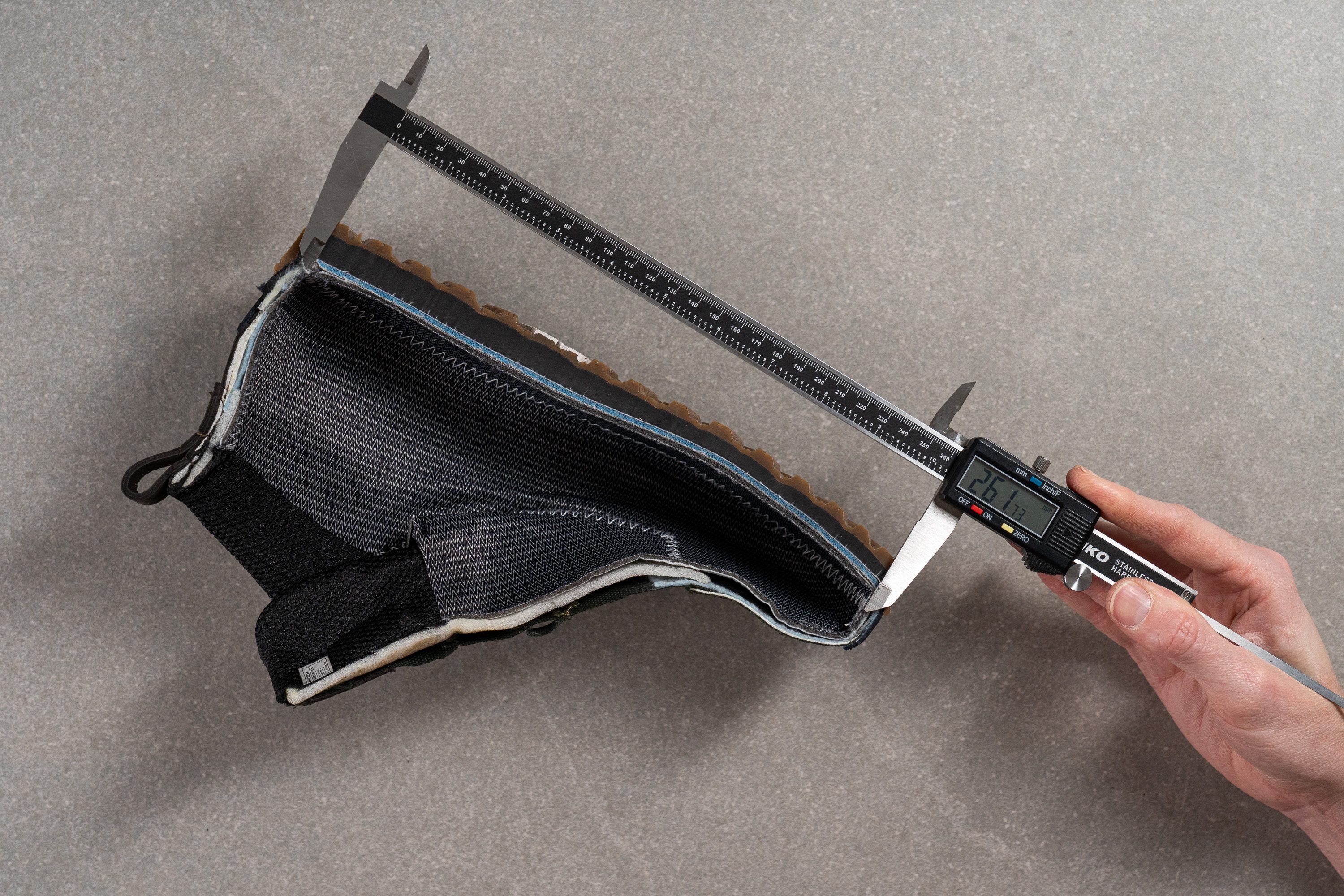
Lo que nos confundió incluso más fue que la marca recomendase en su web comprarse "tu talla estadounidense de siempre" en las Outlander.
Sinceramente, nosotros no estamos de acuerdo, así que nuestro consejo es que te compres al menos medio número más. ¡O incluso un número entero más si piensas ponerte calcetines de lana gorditos!
| Outlander | 261.7 mm |
| Media | 271.4 mm |
Toebox width - widest part
Even though the Outlander runs a bit small length-wise, it certainly doesn't lack space in the toebox. Lems preaches foot health by designing foot-shaped footwear that never squeezes toes and leaves plenty of room for comfortable toe-splay.
Lems offers three types of fit (Medium, Wide, and Widest) and the Outlander features a middle-of-the-road Wide Natural-Shape Fit.
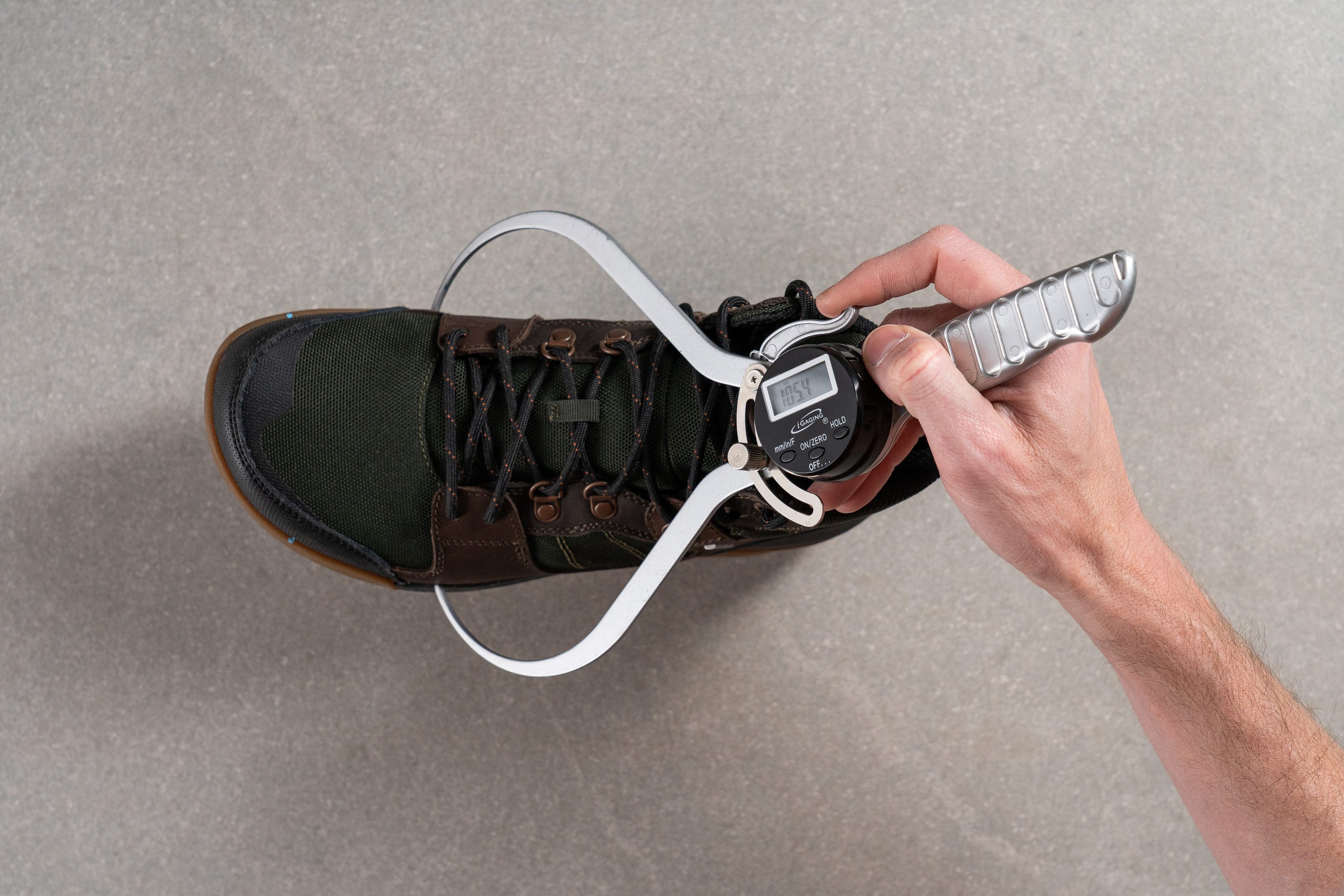
Measuring its widest area with a caliper, we got a bigger-than-average reading of 105.4 mm. We can recommend this hiking boot to folks with wide feet without hesitation.
En esta prueba se utiliza una metodología antigua, así que no verás las zapatillas que hemos analizado últimamente en la tabla. Los resultados obtenidos con metodologías distintas no se pueden comparar.
| Outlander | 105.4 mm |
| Media | 102.1 mm |
Toebox width - big toe
But there's more! The Outlander's toebox remains wide and square even at the tip of the boot. Measuring the area near the big toe, our caliper showed 86.4 mm which is about 8(!) mm wider than average!
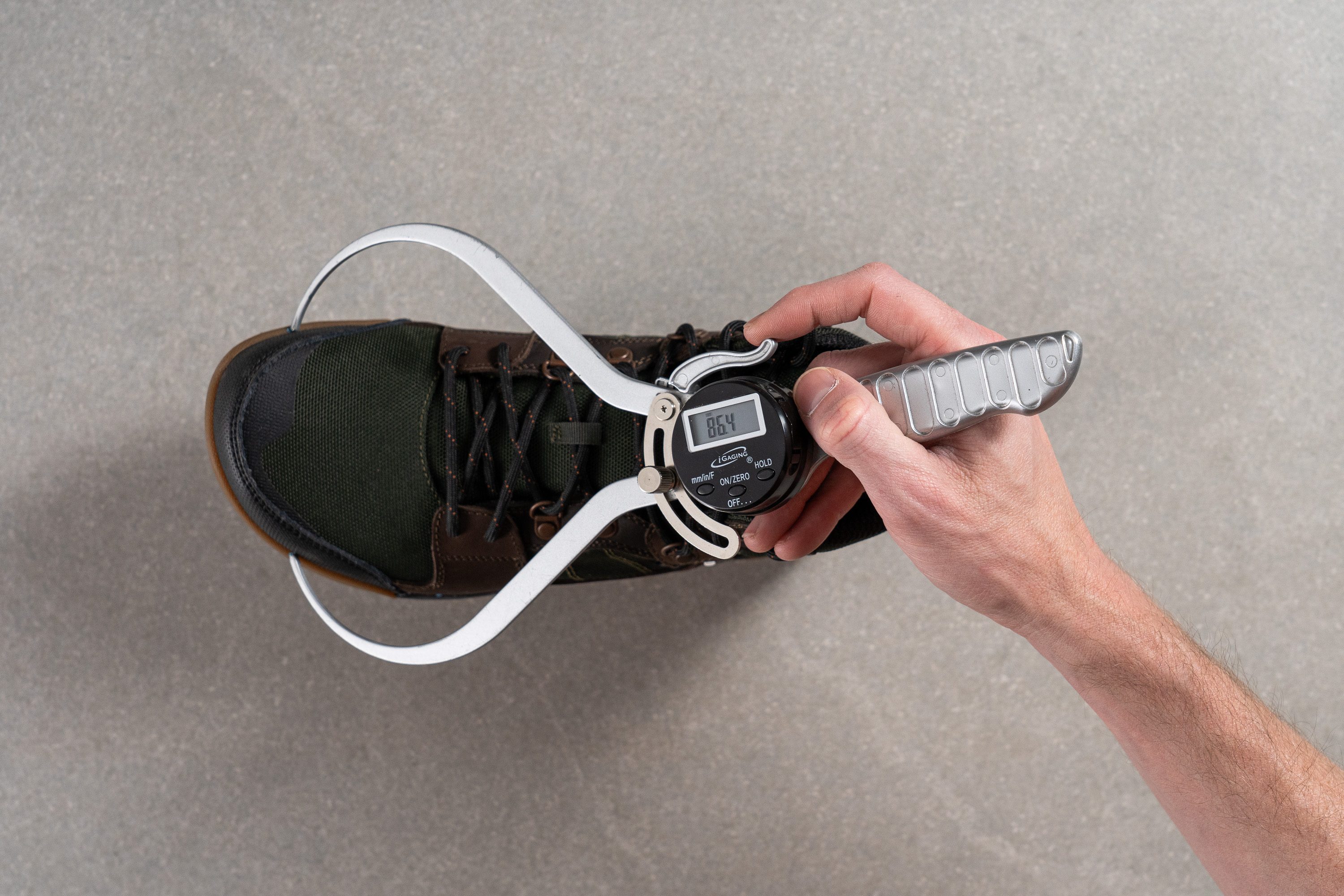
In addition to the toe freedom, we also experienced the benefit of achieving better balance by splaying our toes as much as we needed on rocky terrain.
En esta prueba se utiliza una metodología antigua, así que no verás las zapatillas que hemos analizado últimamente en la tabla. Los resultados obtenidos con metodologías distintas no se pueden comparar.
| Outlander | 86.4 mm |
| Media | 78.6 mm |
Tracción / Agarre
Profundidad del dibujo de la suela
Lems se refiere a los tacos de las Outlander como "dibujo serio" y afirma que su profundidad es de 4 mm. Cuando los medimos en nuestro laboratorio, nos dio 3,5 mm, así que solo hay medio milímetro de diferencia.
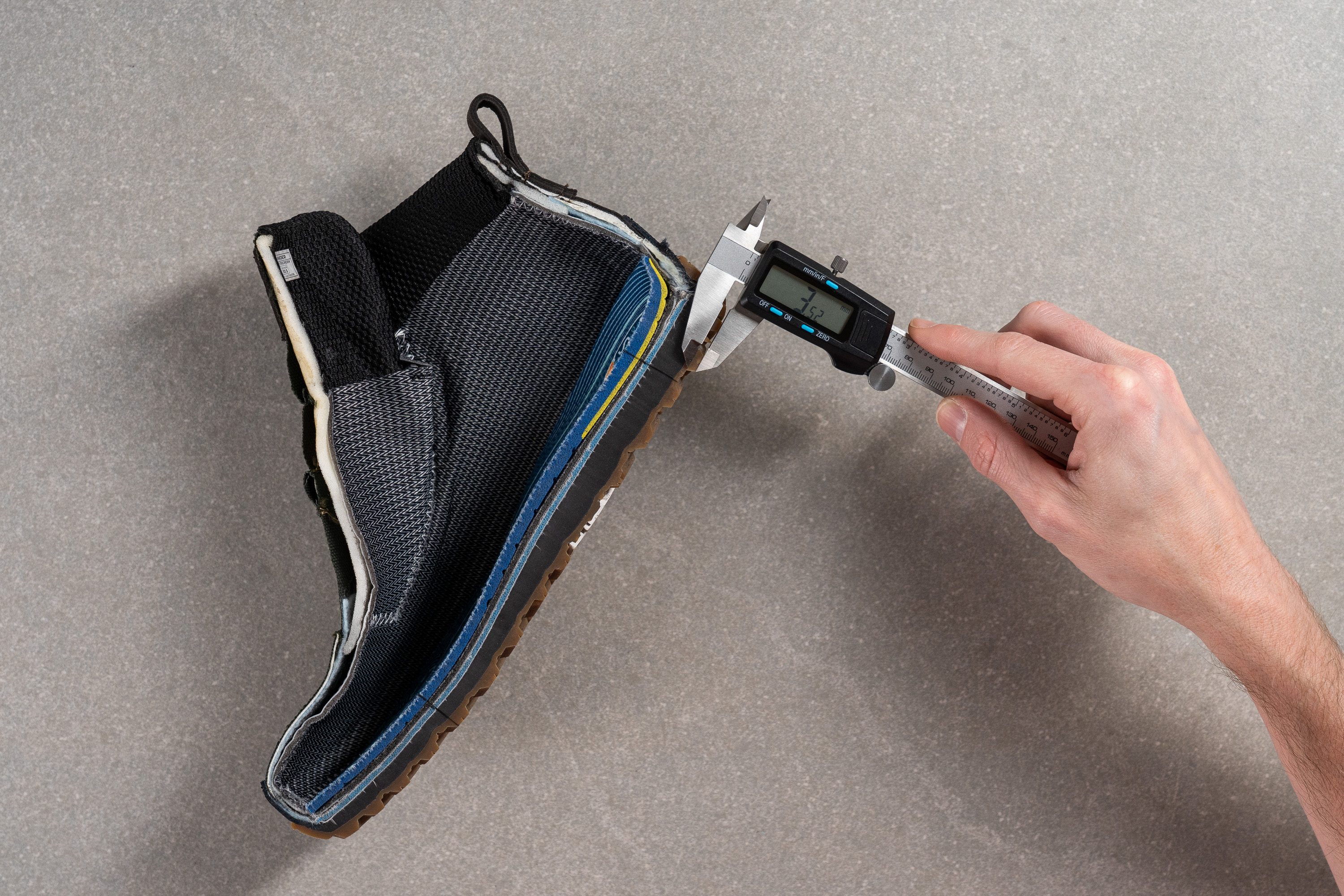
Aunque estos tacos no son de los más profundos que hemos visto en nuestro laboratorio (esos miden 5-6 mm), podemos confirmar su eficacia en terrenos embarrados y nevados. Sin embargo, si tus rutas suelen tener terrenos blandos, a lo mejor prefieres unos tacos más profundos.
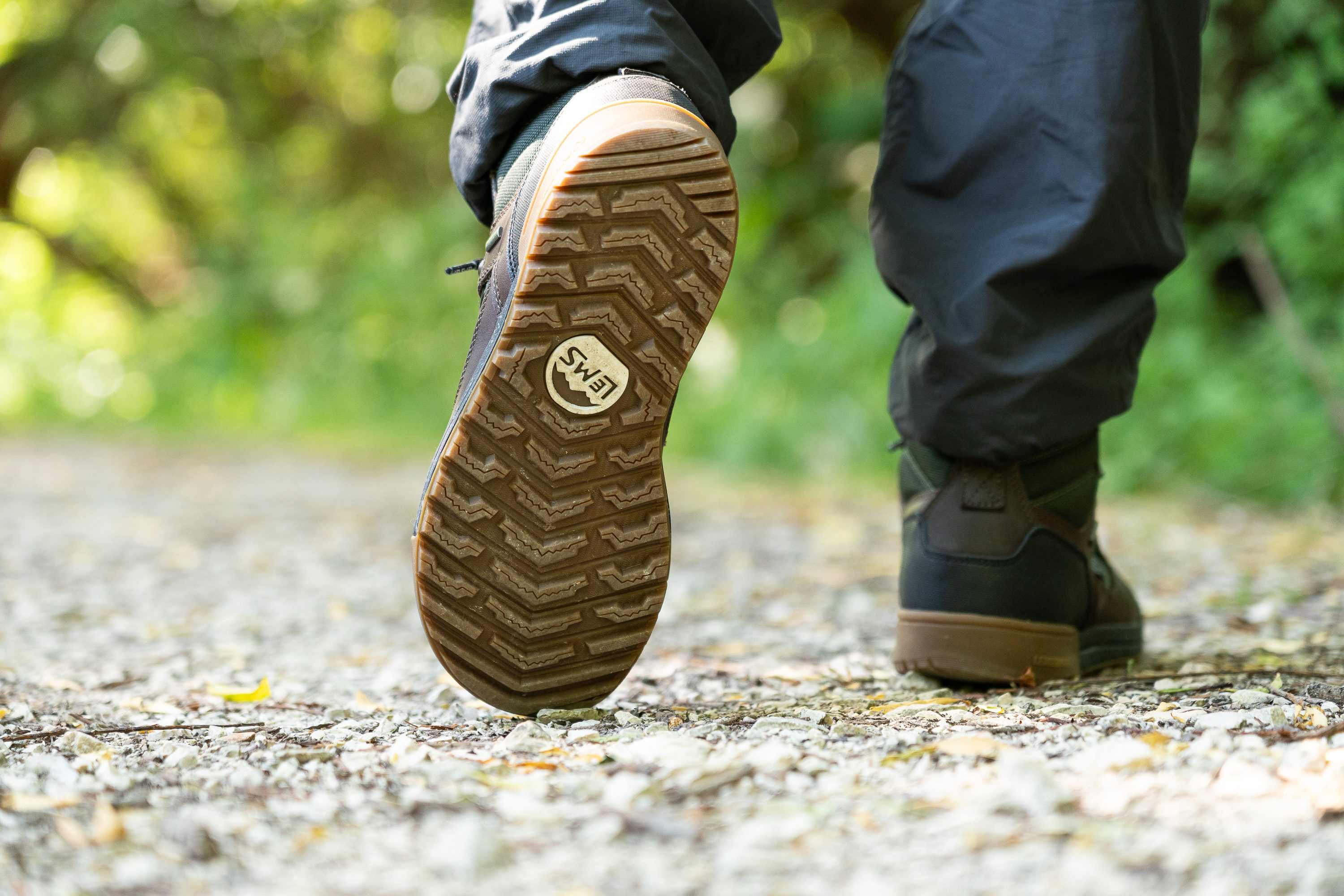
Pero para terrenos que van cambiando y en los que tienes que saltar, escalar por troncos mojados y en los que a veces pisarás musgo, charcos o aguanieve, el dibujo en zig-zag de las Outlander nos ha parecido fiable.
| Outlander | 3.5 mm |
| Media | 4.3 mm |
Flexibilidad / Rigidez
Su diseño minimalista convirtió a las Outlander en unas de las botas de senderismo más flexibles que hemos analizado.
Según nuestro medidor, se necesitaron tan solo 22,8 N para doblarlas hasta un ángulo de 90 grados. ¡Un 95 % menos que la media!
Nos encantó la maniobrabilidad que las Outlander nos proporcionaron en los terrenos técnicos. Esta libertad de movimientos nos ayudó a ser más precisos poniendo los pies en las zonas complicadas, e incluso sentimos que la flexibilidad extra mejoraba el agarre en las rocas, ya que podíamos "abrazar" mejor las superficies con los pies. Si las botas fuesen rígidas o más grandotas, ¡esto sería imposible!
En esta prueba se utiliza una metodología antigua, así que no verás las zapatillas que hemos analizado últimamente en la tabla. Los resultados obtenidos con metodologías distintas no se pueden comparar.
| Outlander | 22.8N |
| Media | 44.3N |
Rigidez en frío (%)
Pero mucho ojo, porque cuando bajan las temperaturas, se pierde parte de esta flexibilidad.
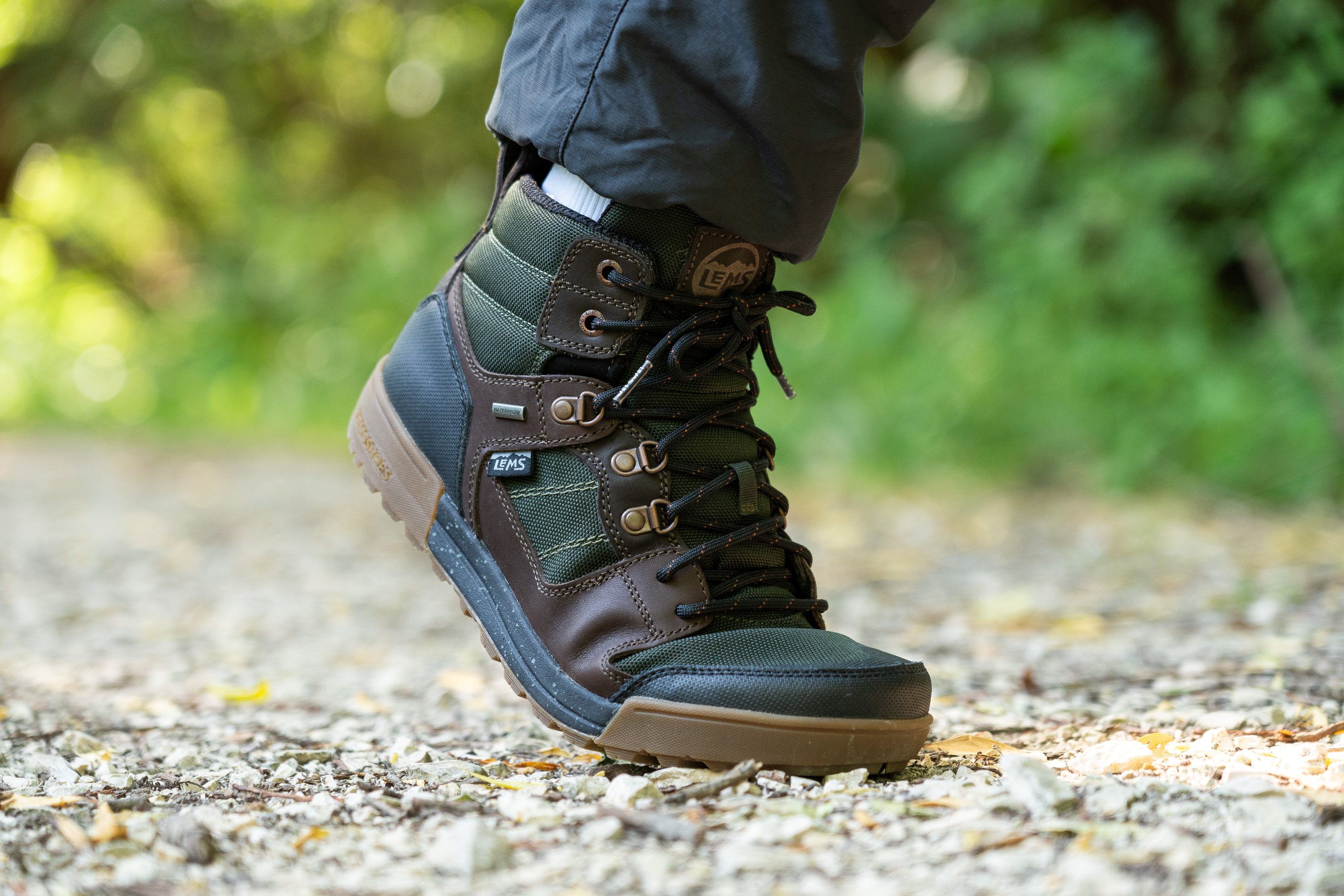
Después de meter las Outlander en el congelador 20 minutos, nos decepcionó un poco comprobar que ahora necesitaban un 32,2 % más de fuerza para doblarse.
Lo bueno es que, incluso después de estar medio congeladas, siguen siendo más flexibles que la mayoría de las botas de senderismo a temperatura estándar.
| Outlander | 32% |
| Media | 24% |
Peso
Como botas de senderismo más bien minimalistas, las Lems Outlander consiguen que su peso no se pase de la raya.
Con unos moderados 434 g (15,3 oz), son casi 100 g más ligeras que la media.
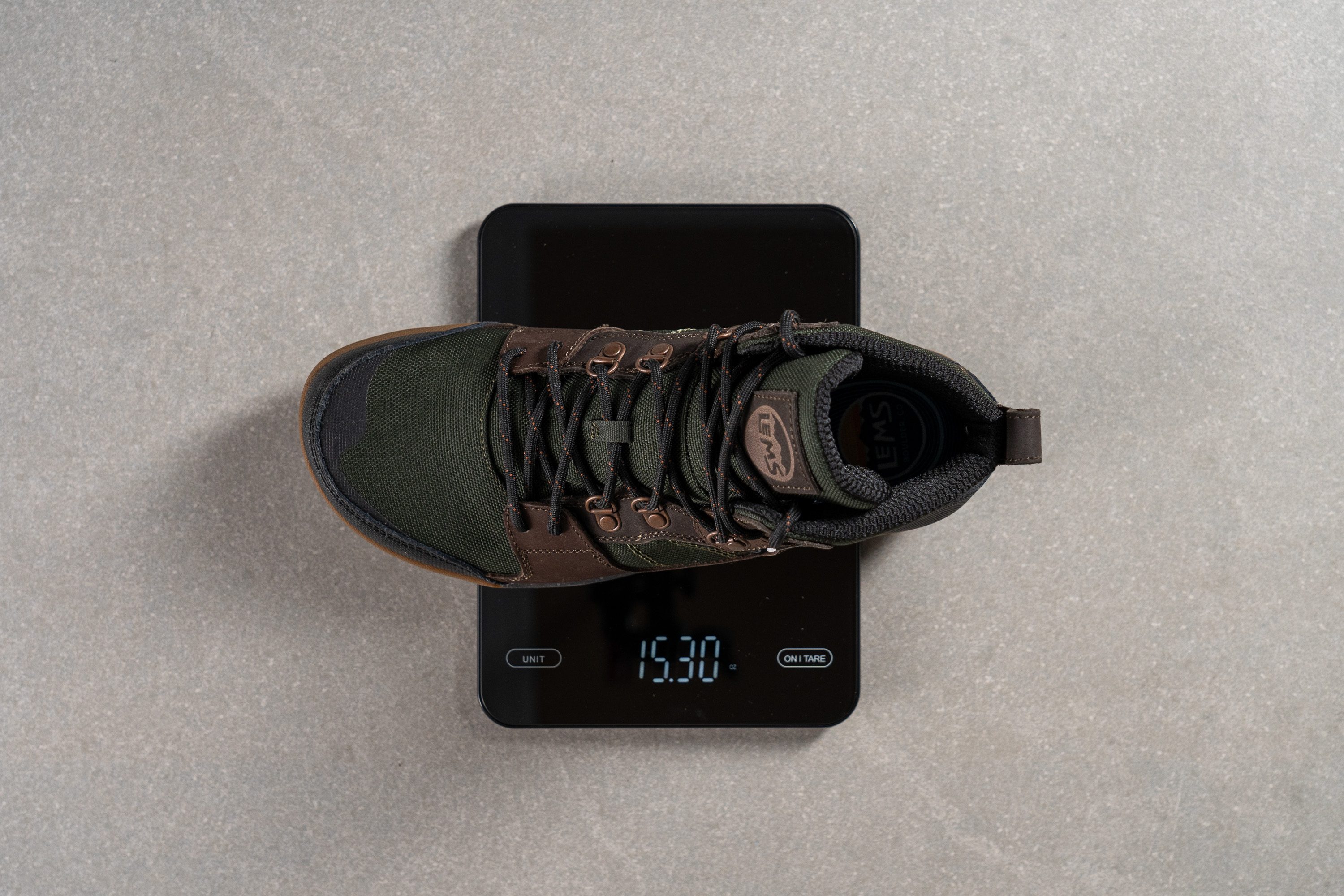
La verdad es que nos sorprendió que no consiguiesen colarse entre las botas más ligeras de nuestra lista, pero en los pies sí que se sienten más ligeras de lo que dice nuestra báscula.
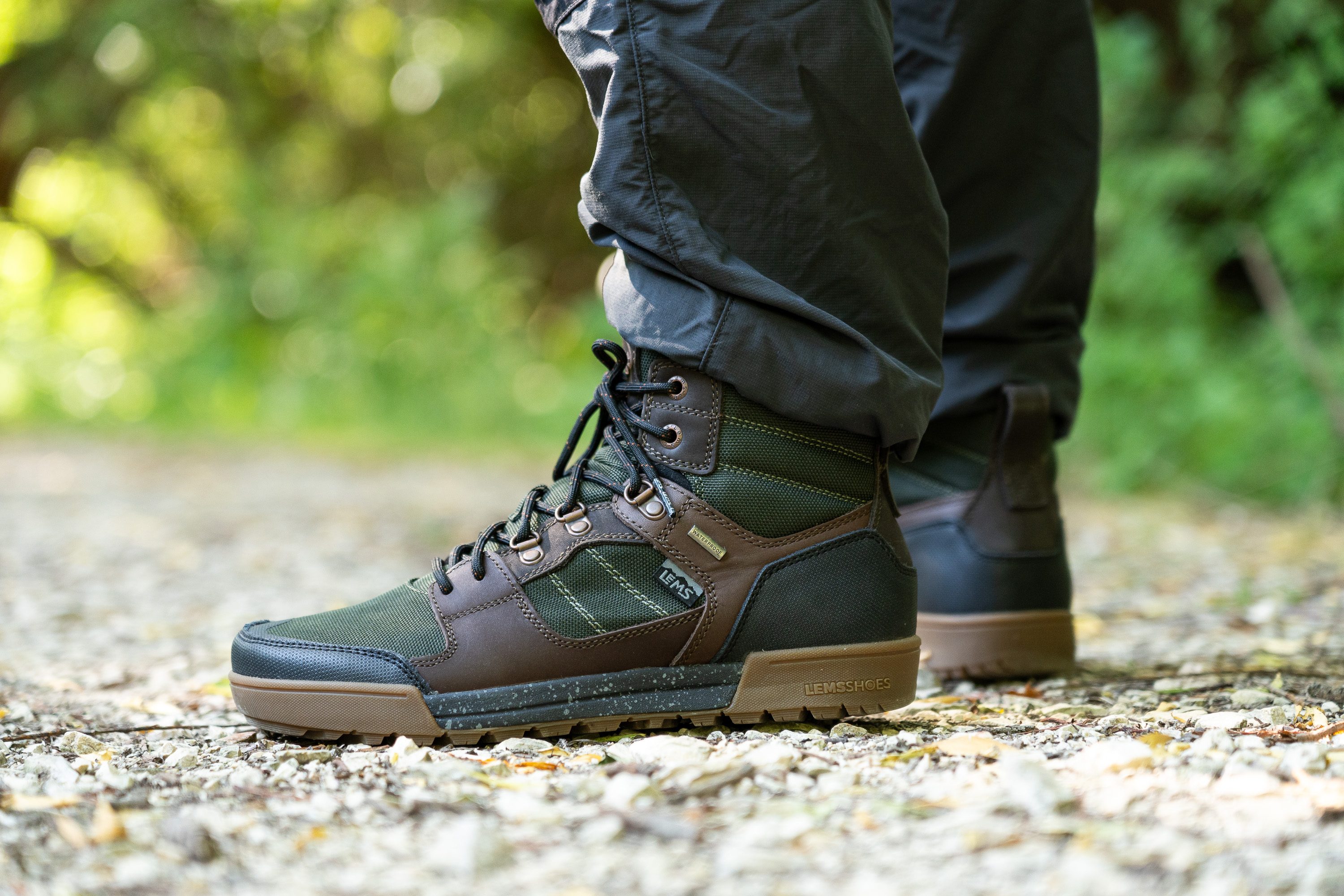
Personalmente, a nosotros las Outlander nunca hicieron que nos pesasen los pies, ni tampoco nos las quisimos quitar a mitad de camino.
| Outlander | 15.3 oz (434g) |
| Media | 18.7 oz (531g) |
Transpirabilidad
Como botas de senderismo impermeables, las Outlander no son lo más transpirable del mercado, y en nuestras pruebas de laboratorio nos quedó bien clarito.
Teniendo en cuenta que ni un poquitito de humo consiguió atravesar la parte delantera de nylon de estas botas, no nos costó nada darles un 1/5, que es la puntuación más baja posible.
Además, este nylon tiene un diseño muy sólido, ¡así que ni con nuestro microscopio conseguimos encontrarle un poro!
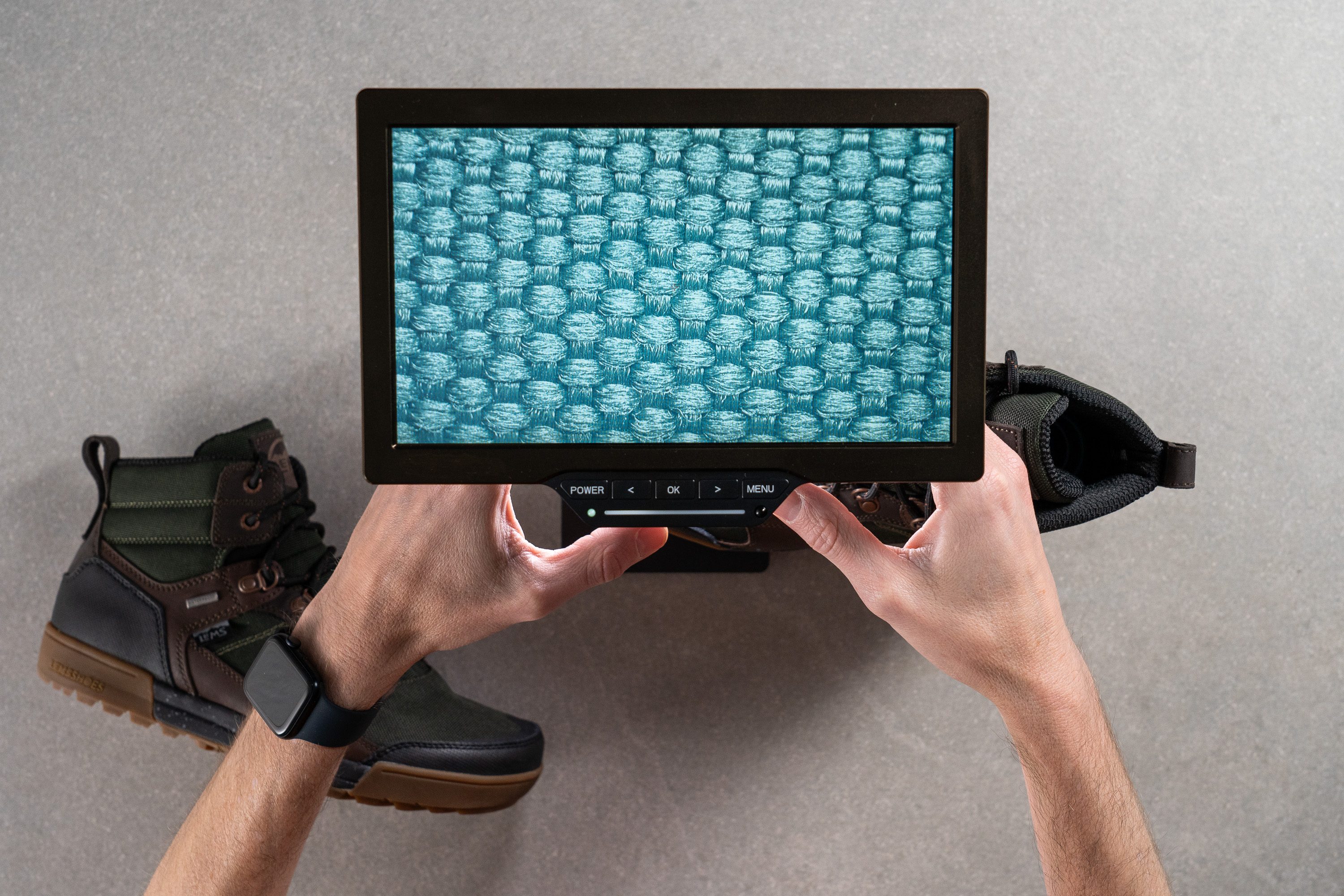
Lo bueno es que este material es perfecto para mantener los pies secos y calentitos cuando tenemos que ponerle al mal tiempo buena cara.

| Outlander | 1 |
| Media | 1.3 |
Resistencia al agua
Las Outlander utilizan el mismo forro impermeable que las famosas botas Boulder de la marca. Esta membrana no tiene nombre, pero su rendimiento es maravilloso.
Lluvia, riachuelos y aguanieve..., ¡las Outlander pueden con todo! Dejando a un lado los climas extremos, nos parecen unas botas bastante versátiles para las 4 estaciones. De hecho, hemos comprobado que, escogiendo los calcetines adecuados, estas Lems consiguen que estemos cómodos de temperaturas entre -1°C y 21°C.
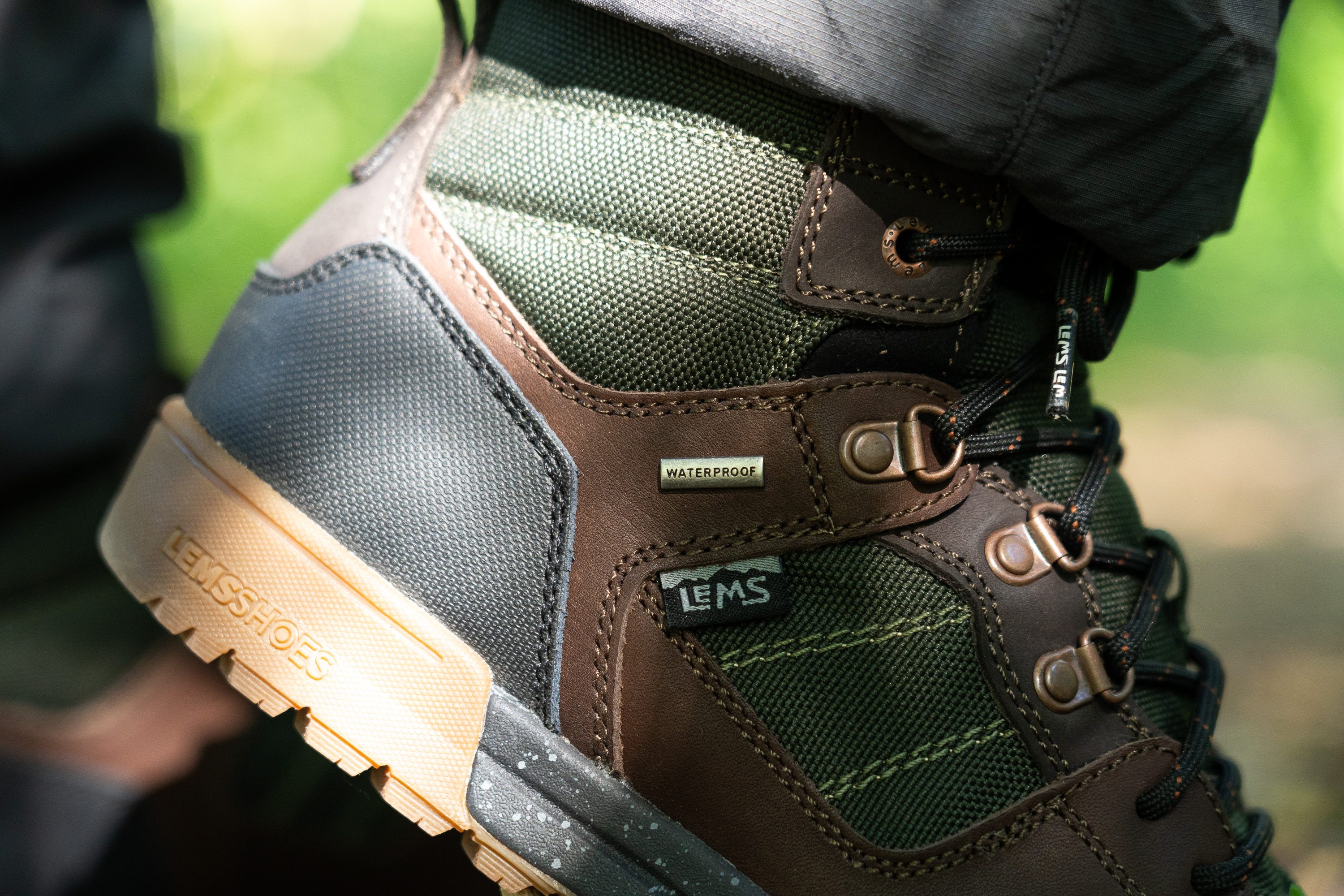
La marca también les recuerda a los usuarios que la impermeabilidad de estas botas durará siempre y cuando:
- Las limpies de forma regular.
- Vuelvas a aplicar el tratamiento impermeabilizante.
- Las guardes bien (en un lugar fresco y seco).
- Le eches un ojo a las costuras y a los puntos de vez en cuando.
Estabilidad
Prueba de estabilidad lateral
Nos quedamos boquiabiertos con cómo las Outlander nos hicieron sentirnos estables sin tener ningún componente rígido de estabilidad ni una estructura voluminosa.
Nunca sentimos que nos faltaba equilibrio, ni siquiera cuando el terreno se volvió accidentado y difícil. Suponemos que la firme plataforma de estas botas es su fuente principal de estabilidad.
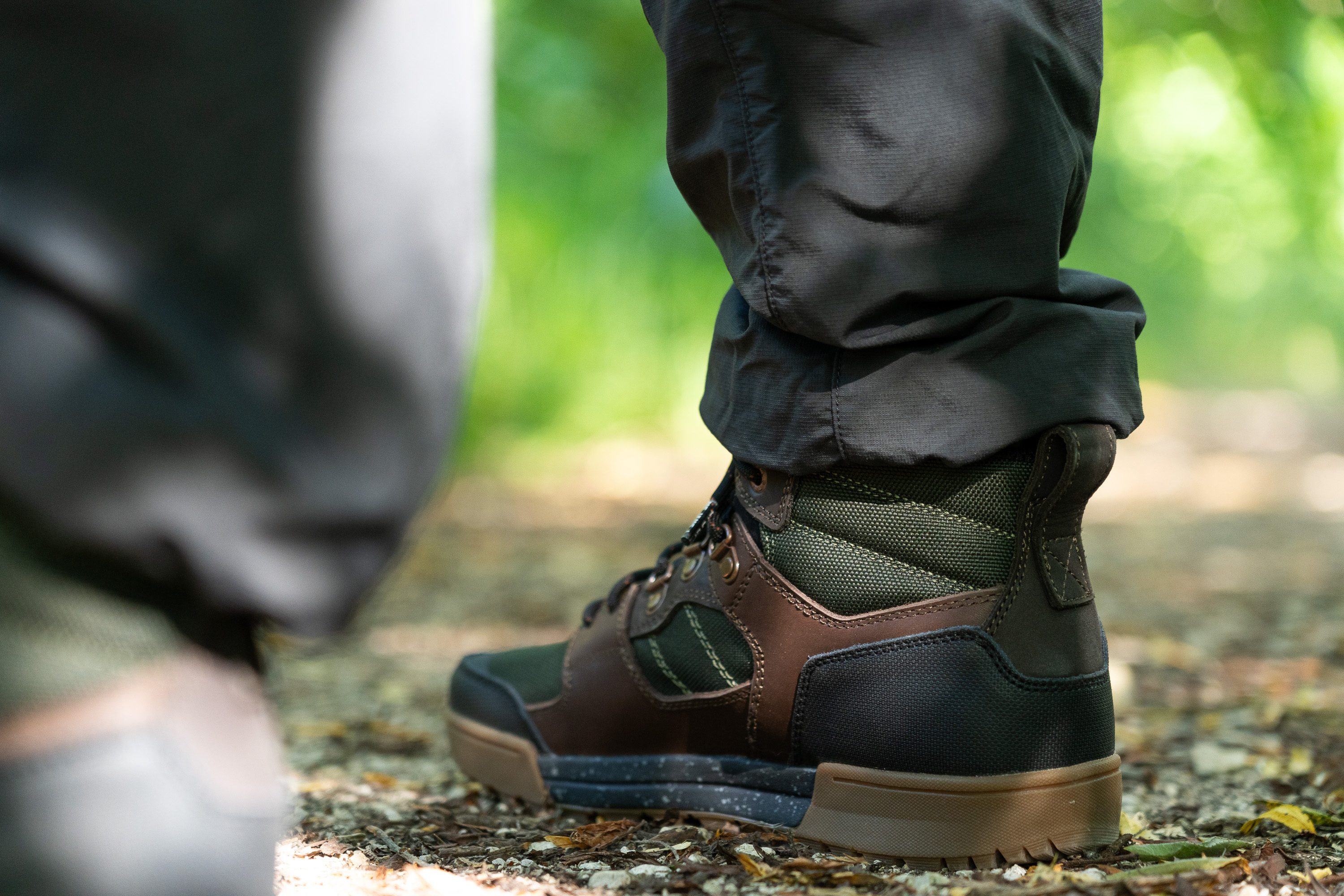
Rigidez torsional
El sencillo diseño de las Outlander no incluye cambrillones rígidos ni otros elementos estabilizadores para evitar que el pie se doble. Pero, sinceramente, nunca sentimos que estas botas los necesitasen.
Nos costó muy poco retorcerlas en nuestra prueba manual, así que les hemos dado un 3/5 en rigidez torsional. Esta puntuación hace que estén en el grupo de las botas de senderismo flexibles.
| Outlander | 3 |
| Media | 4.4 |
Rigidez del contrafuerte del talón
Tampoco sentimos que nos estrujasen el talón o el tobillo como un par de esposas.
Empujamos el contrafuerte del talón de las Outlander con los dedos y decidimos darle una puntuación moderada, así que se llevaron otro 3/5.

Eso sí, queremos que quede claro que esta flexibilidad nunca hizo que nuestros talones se escurriesen o se moviesen de un lado al otro. La parte de atrás de nuestros pues se mantuvo segura y en su sitio mientras disfrutábamos de la sujeción que las Outlander nos proporcionaron sin estrujarnos los pies.
| Outlander | 3 |
| Media | 3.6 |
Anchura de la mediasuela - antepié
Parece que Lems tiene claro que no va a ponerle a sus botas nada que no necesiten.
Comprobamos que las dimensiones de la suela de las Outlander no superan la media de las botas de senderismo, pero nunca nos faltó anchura para sentirnos estables.
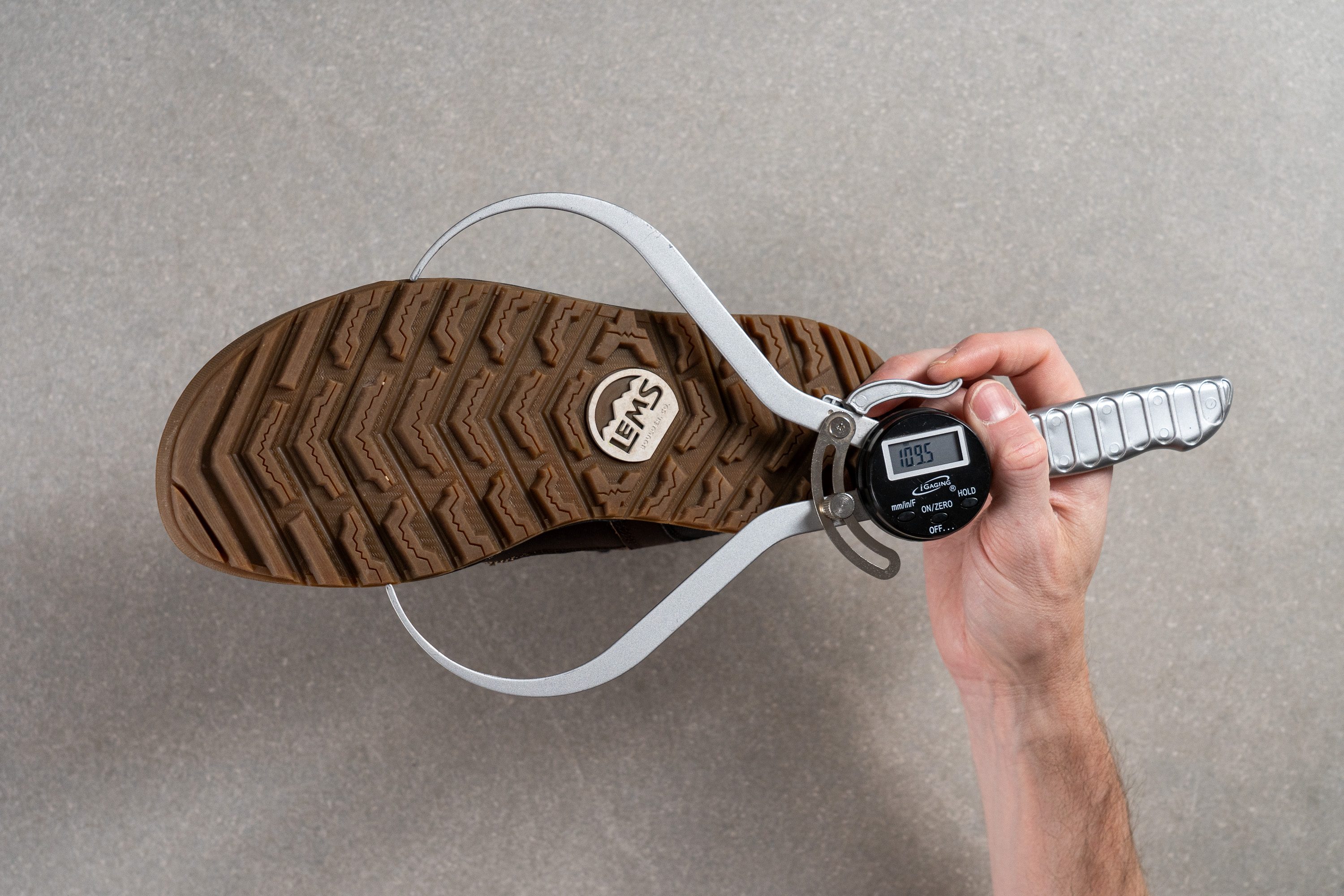
Al medir la zona más ancha de la suela de estas botas, nuestro calibre marcó 109,5 mm, que es una anchura inferior a la media.
| Outlander | 109.5 mm |
| Media | 111.5 mm |
Anchura de la mediasuela - talón
El talón de las Outlander es bastante más estrecho que la media, con 82,4 mm. Pero, una vez más, esto tampoco hizo que se tambaleasen o que fuesen inestables.
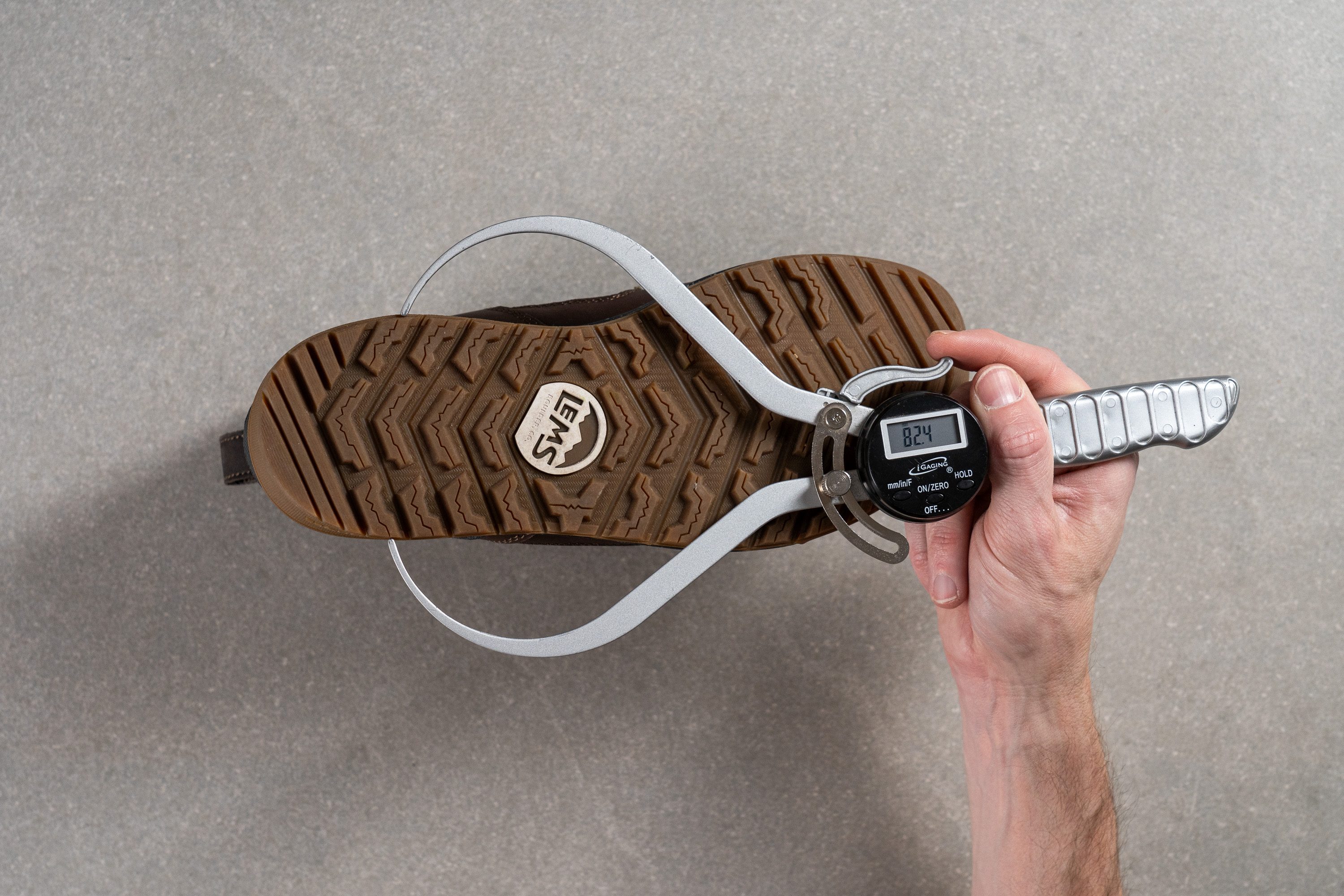
| Outlander | 82.4 mm |
| Media | 87.6 mm |
Durabilidad
Durabilidad de la parte delantera
El diseño de la parte superior de las Outlander es bastante minimalista en comparación con la mayoría de las botas de senderismo del mercado. Tienen un refuerzo sólido en el antepié para los golpes contra las rocas y las raíces, pero la parte de arriba de la zona de los dedos no tiene nada más que nylon expuesto.
¡Vamos a ver si este material está preparado para los cortes y los roces contra los obstáculos que nos pone la naturaleza!
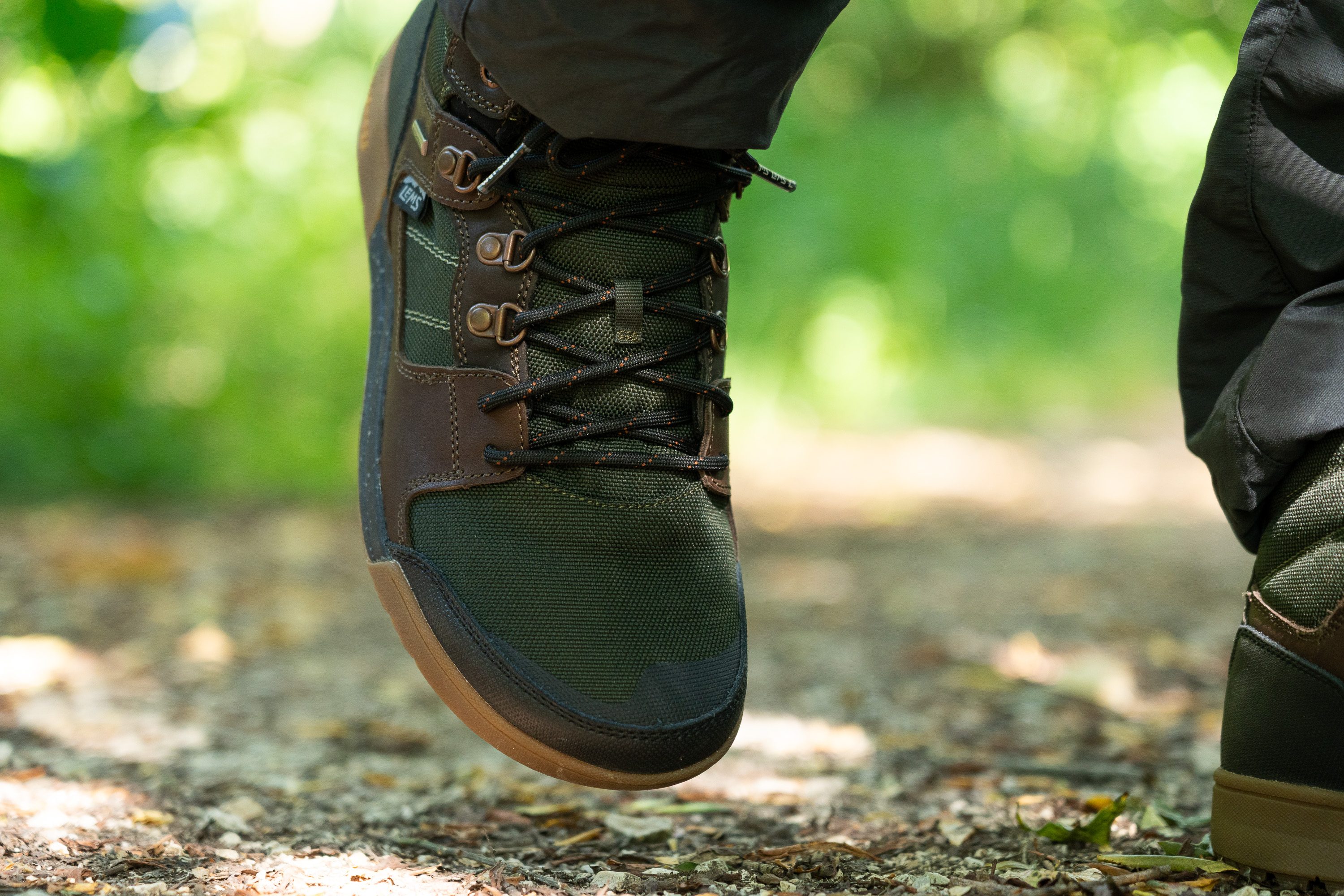
Equipados con un Dremel, fuimos a por la parte delantera de estas botas a 5K RPM y con una presión de 3,2 N. Después de torturarla durante 12 segundos, nos alegró ver que el nylon aguantó, pero la capa protectora que tenía encima desapareció por completo. Por lo tanto, tuvimos que bajarles un poco la nota.
Con un 4/5 en durabilidad de la parte delantera, podemos confirmarte que la durabilidad del upper de las Outlander está a la par con la mayoría de botas de senderismo que hemos analizado, ¡incluso superando a algunas de ellas!

| Outlander | 4 |
| Media | 4.3 |
Durabilidad del acolchado del talón
En el interior, el cuello de las Outlander está forrado con una tela de poliéster bastante estándar.
Cogimos nuestro Dremel una vez más y le dimos caña durante 4 segundos a una velocidad de 5K RPM. El material se peleó con la herramienta y no sufrió daños importantes, así que estas Lems se han llevado otro 4/5 en durabilidad.
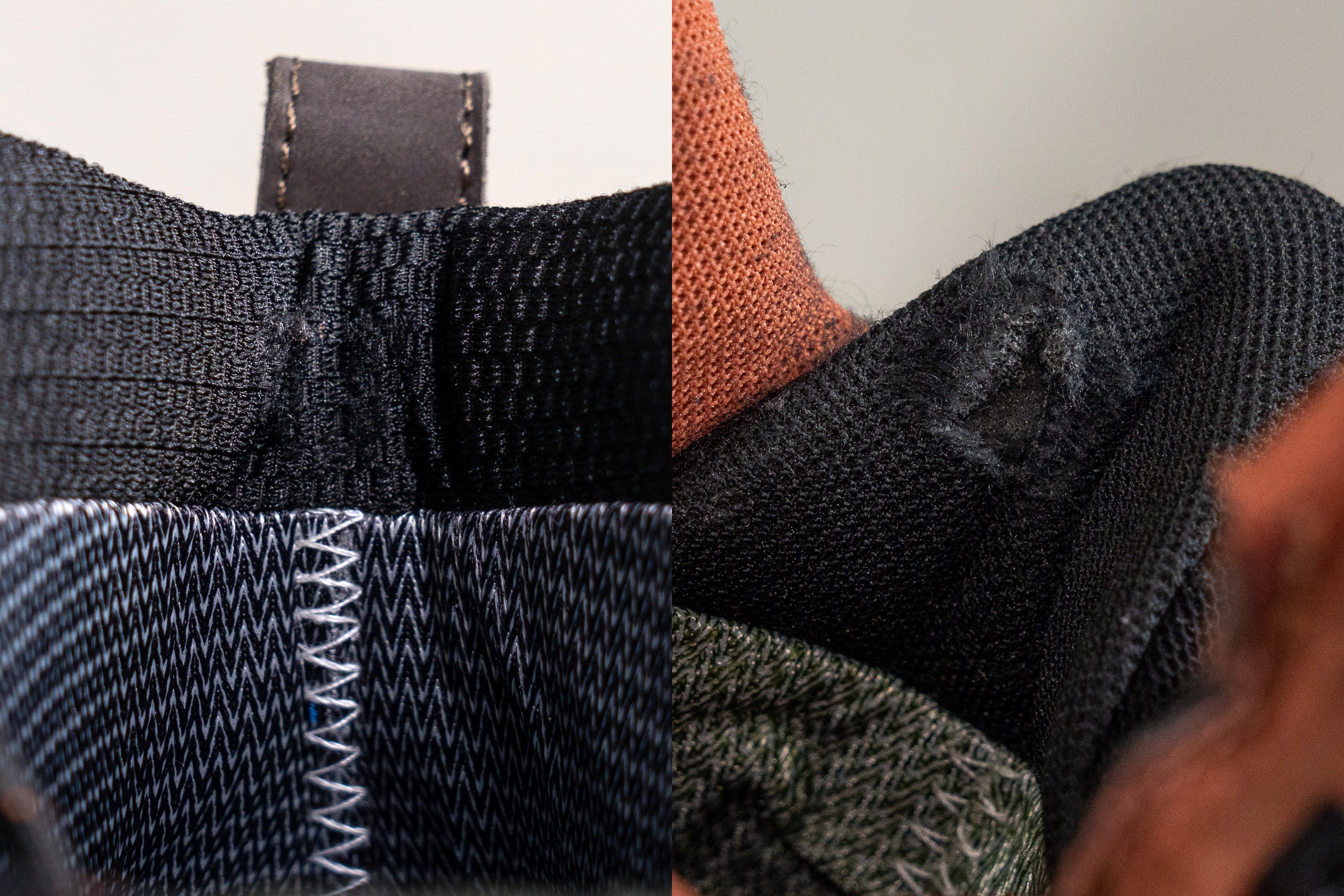
| Outlander | 4 |
| Media | 3.6 |
Dureza de la suela
Las Outlander utilizan un compuesto de caucho patentado para su suela exterior. No nos pareció demasiado firme, pero tampoco es que fuese blando y que ofreciese mucho agarre.
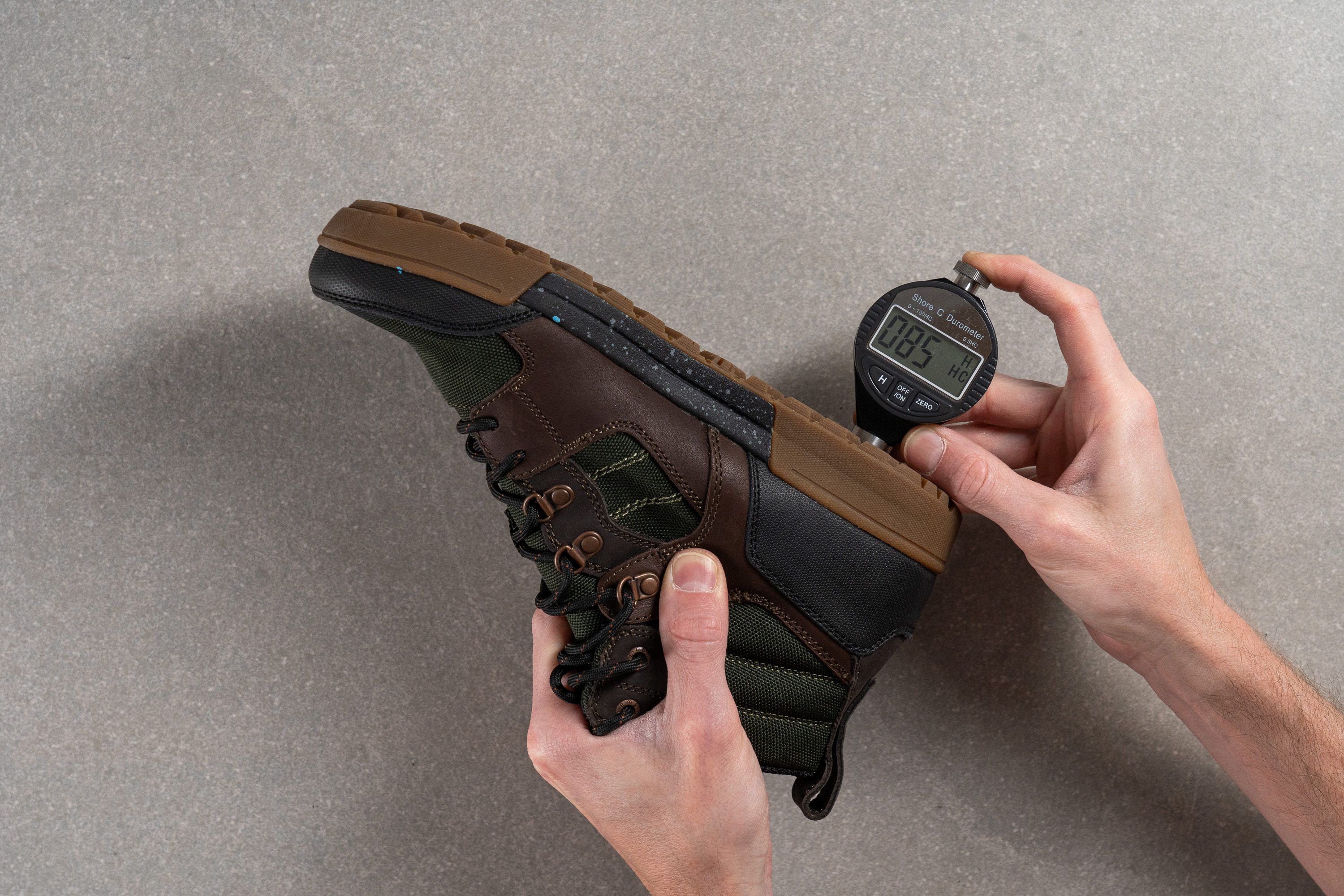
Nuestro durómetro lo confirmó al marcar 85,1 HC, que es casi la misma dureza que la media.
| Outlander | 85.1 HC |
| Media | 87.1 HC |
Durabilidad de la suela
El material de la suela exterior de estas botas superó nuestra prueba de durabilidad con nota.
Después de darle caña con el Dremel durante 22 segundos a 10K RPM, el caucho terminó con unos daños de profundidad estándar, ya que nuestro medidor marcó 1,0 mm.

| Outlander | 1.0 mm |
| Media | 0.8 mm |
Grosor de la suela
Lo único que nos preocupaba era el grosor del caucho, ya que solo mide 2,0 mm, por lo que es bastante más fino que la media.
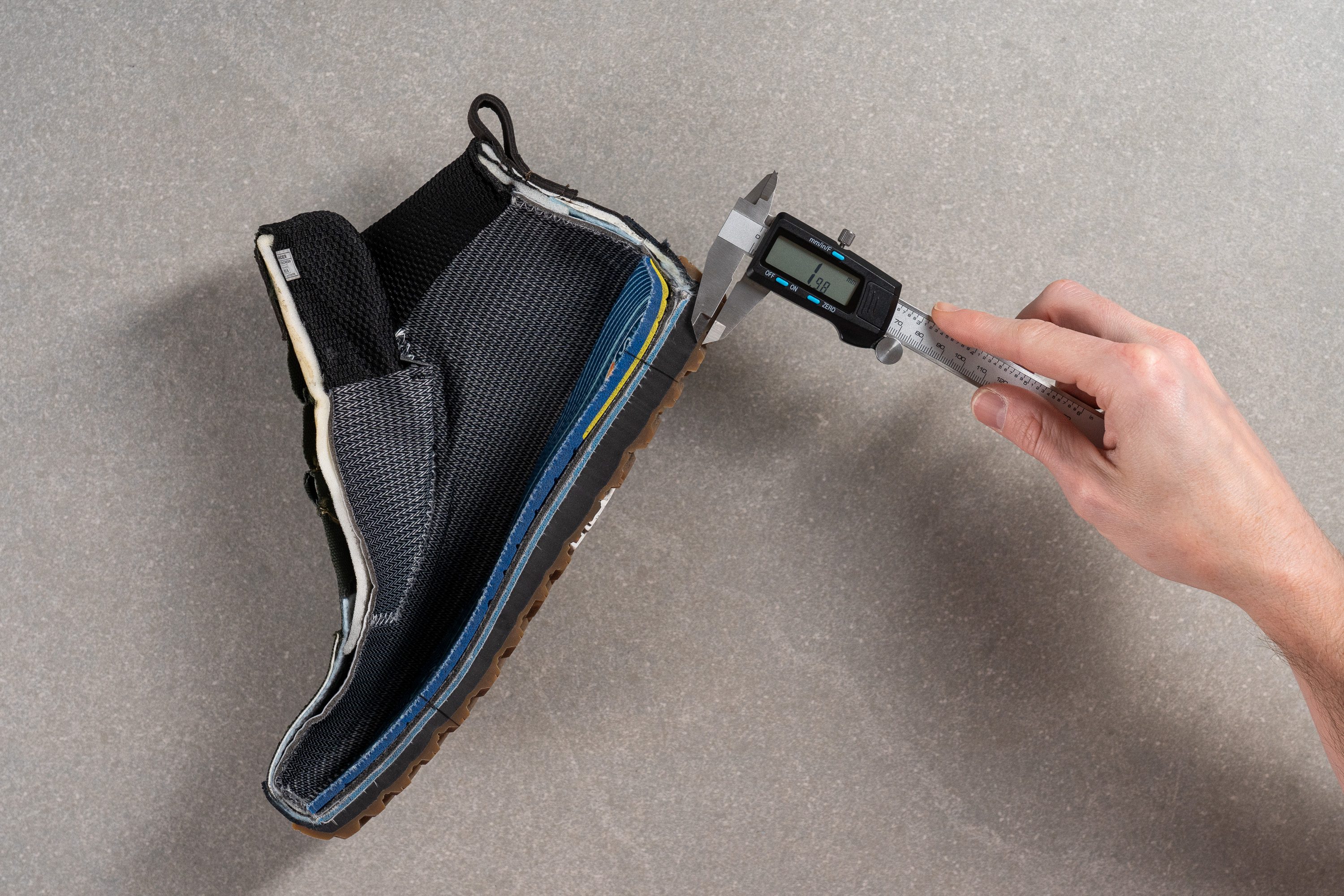
Después de tener en cuenta estas 3 pruebas, creemos que las Outlander tienen una suela exterior hecha para durar. No es la más resistente que hemos visto en una botas de senderismo, eso está claro, pero nos parece bastante fiable.
| Outlander | 2.0 mm |
| Media | 2.9 mm |
Varios
Grosor de la plantilla
La plantilla de estas botas está muy acolchada, ya que nuestro calibre marcó 7,2 mm en el talón. Sorprendentemente, las especificaciones de la marca dicen que la plantilla es de solo 5,5 mm, pero espera, porque aún hay más.
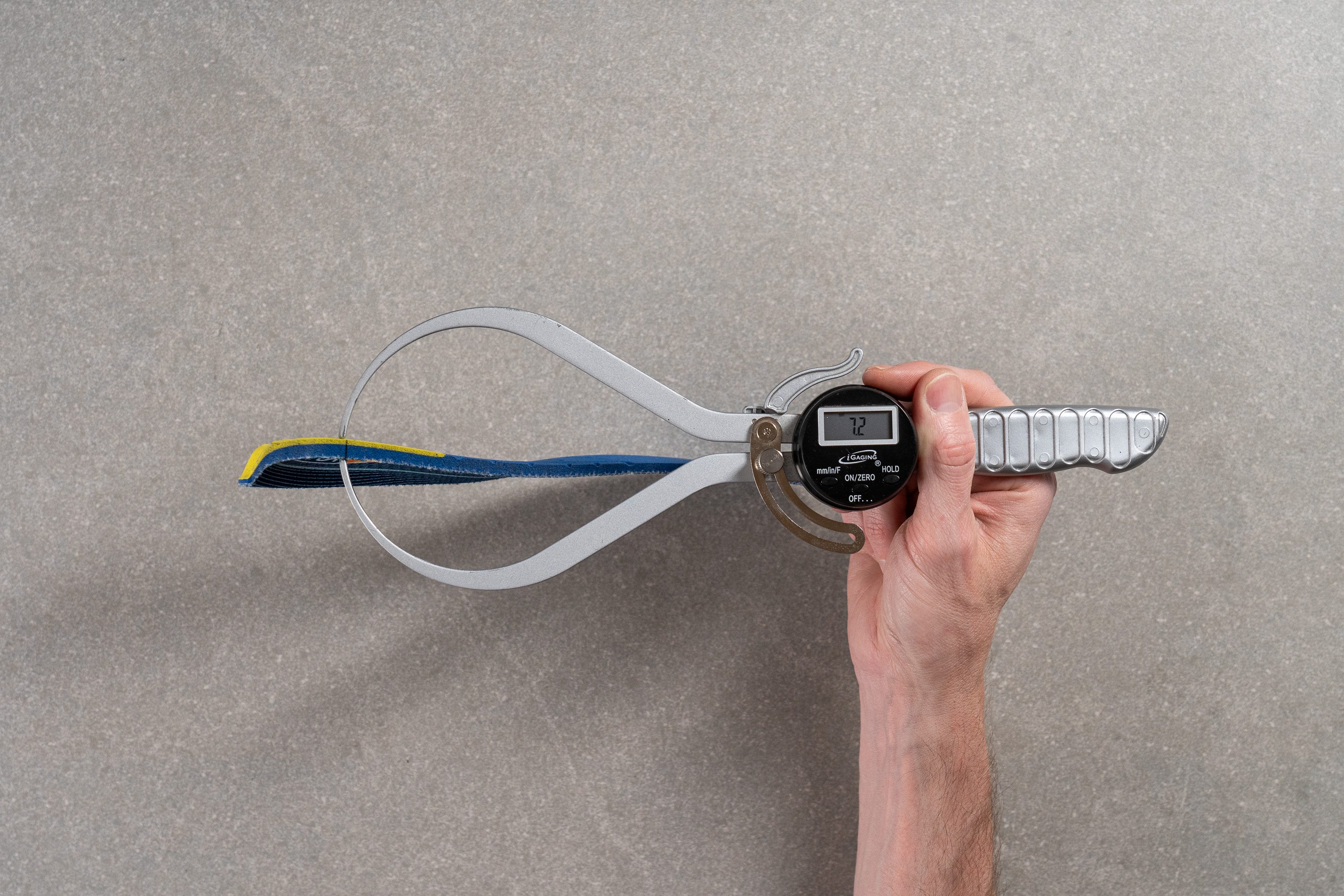
Lems lleva el cuidado del pie al siguiente nivel poniéndoles la plantilla Adventure Poly a las Outlander. Es más blanda por arriba y más firme por abajo, además de que se adapta ergonómicamente al pie.

Disfrutamos mucho del confort que esta plantilla nos proporcionó, sobre todo porque la suela de las botas es muy firme, ¡y descubrimos que hasta la puedes comprar por separado en la web de la marca!
| Outlander | 7.2 mm |
| Media | 6.0 mm |
Plantilla extraíble
La plantilla de las Outlander es fácil de quitar, y la puedes cambiar por cualquier otra si lo necesitas o si quieres tener un poco más de espacio en las botas.

| Outlander | Sí |
Rigidez de la mediasuela en frío (%)
Que una suela sea firme desde el principio quiere decir que la sensación será consistente tanto si hace calor como si hace frío.
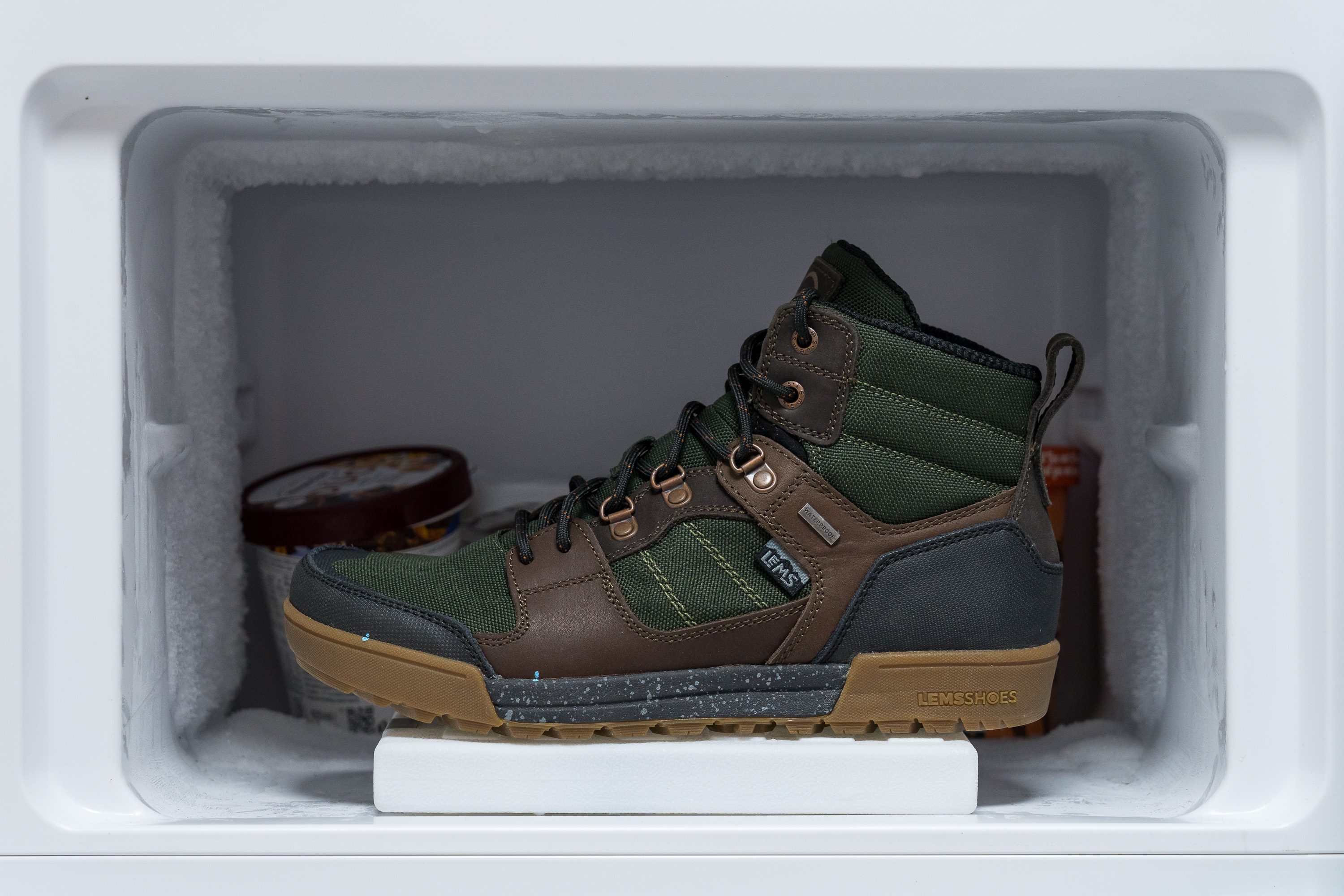
Después de dejar que las Outlander estuviesen 20 minutos en el congelador, descubrimos que su mediasuela solo se volvía un 8 % más firme, mientras que las espumas mullidas de otros modelos pueden llegar a endurecerse en un 40-50 %.
| Outlander | 8% |
| Media | 20% |
Elementos reflectantes
Estas Lems no son muy últiles cuando cae la noche, ya que no tienen elementos reflectantes.
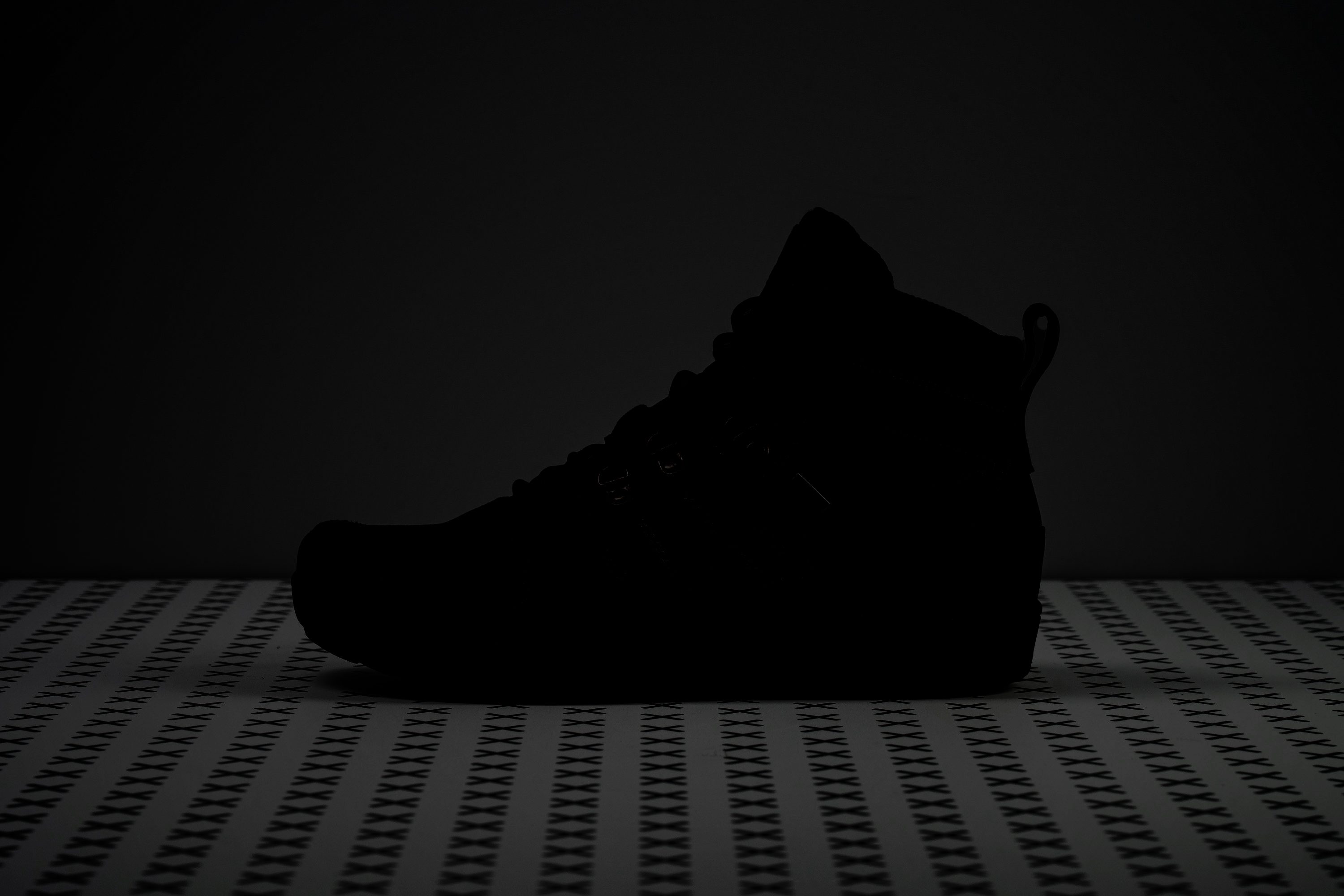
| Outlander | No |
Acolchado de la lengüeta
Aunque las Outlander tienen un diseño minimalista, cuentan con el acolchado suficiente donde más lo necesitan. Tienen la espuma necesaria en la lengüeta (10,1 mm), que protegió nuestros empeines de la presión de los cordones bastante bien.
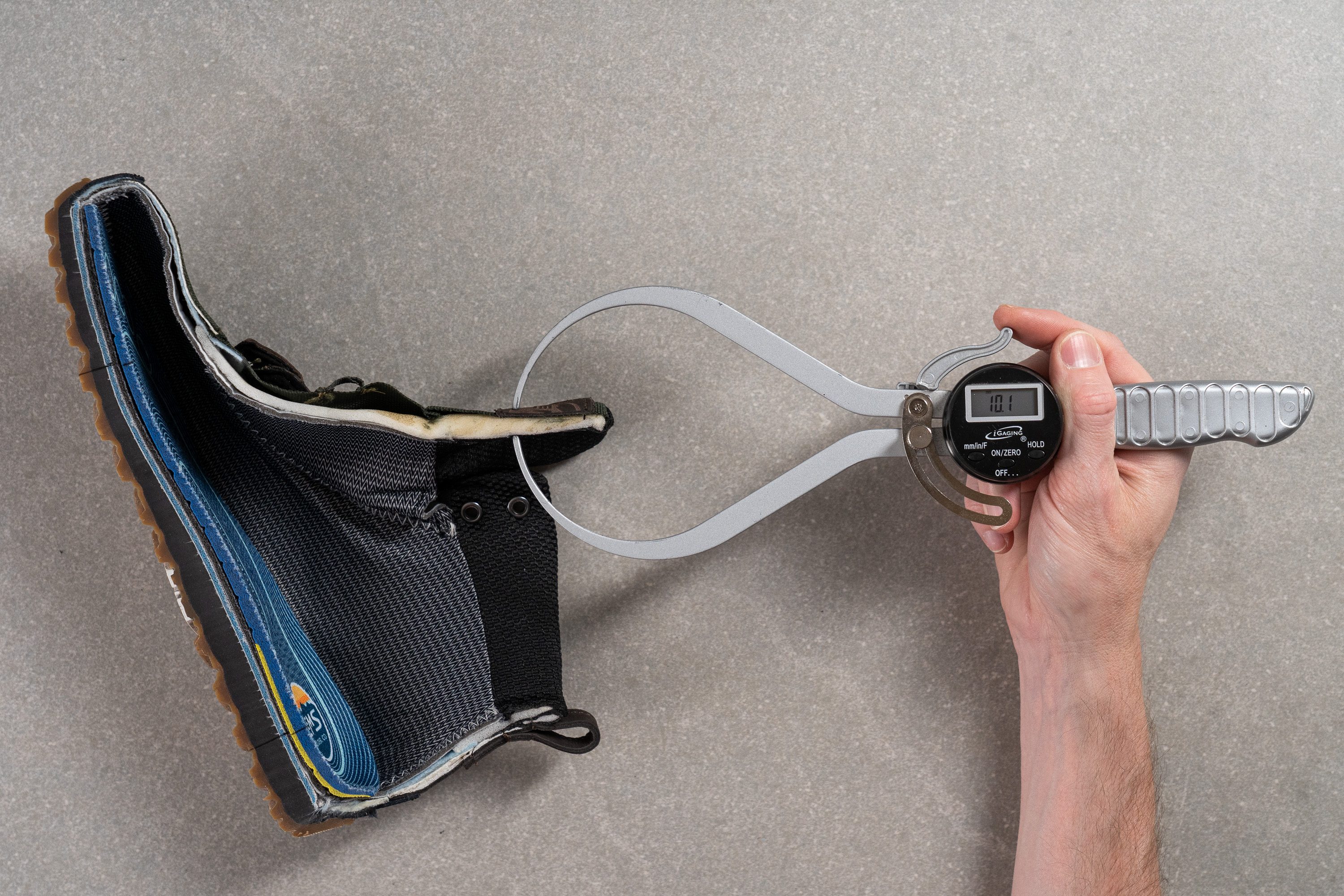
| Outlander | 10.1 mm |
| Media | 11.2 mm |
Lengüeta: tipo de refuerzo
Una lengüeta reforzada es imprescindible en unas botas de senderismo impermeables. Una vez más, no tenemos más que palabras bonitas para las Outlander, ya que los refuerzos ayudan a que el agua, las piedrecillas y la tierra no se te cuelen dentro de las botas.

| Outlander | Ambos lados (completo) |
Tirador del talón
Cuando nos calzamos, sentimos que el tirador de estas botas era muy útil. En comparación con los lacitos frágiles de la mayoría de las zapatillas/botas que hemos analizado, este diseño de cuero tan resistente parece aguantar bien los tirones.

| Outlander | Tirador circular |

